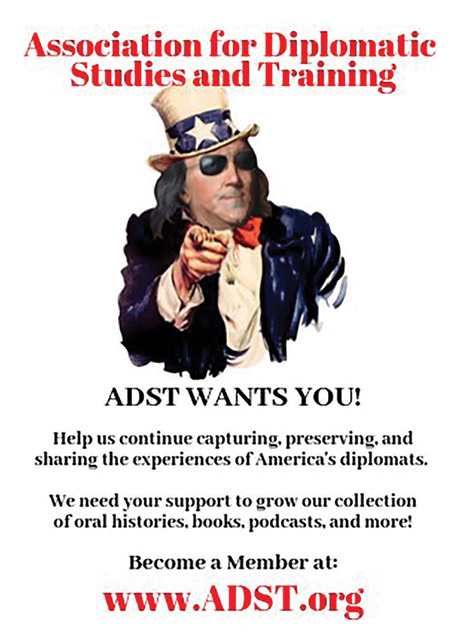Remembering 1989: Berlin Wall Stories
Diplomats reflect on the events that dramatically reshaped the postwar world.
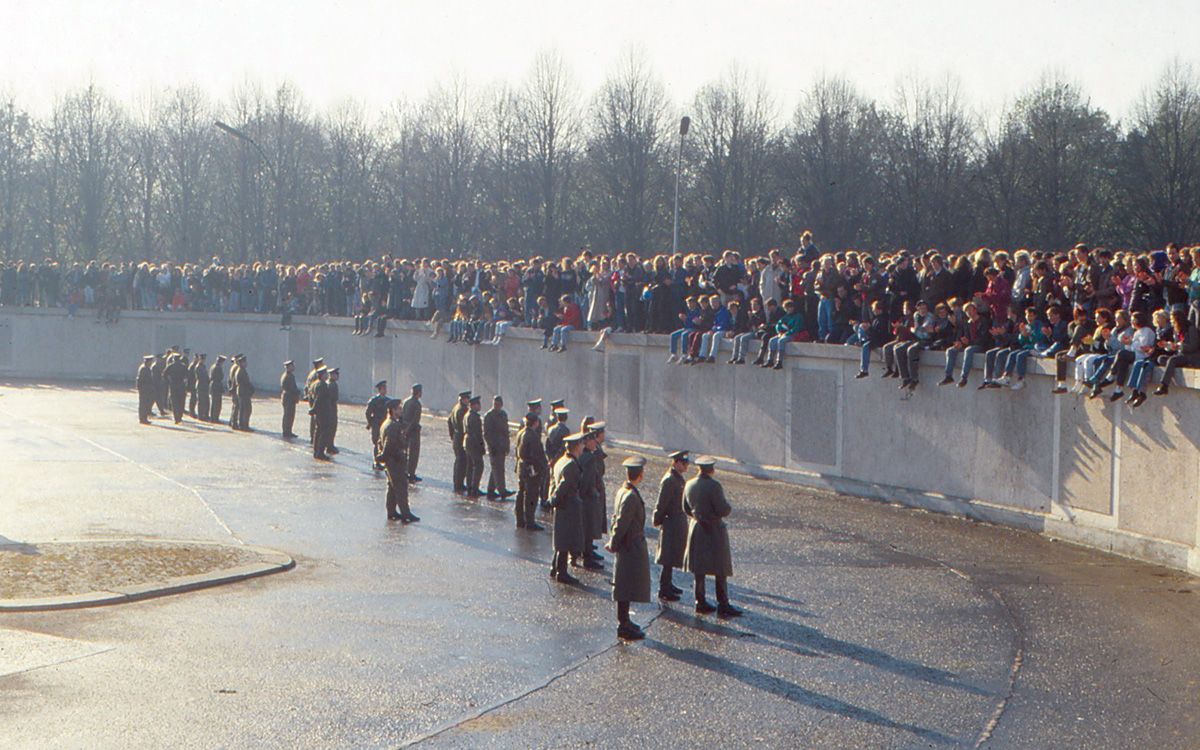
A view of the east side of the wall at the Brandenburg Gate, where West Berliners perched atop the barrier taunt the East German police on Nov. 10, 1989.
Michael Hammer
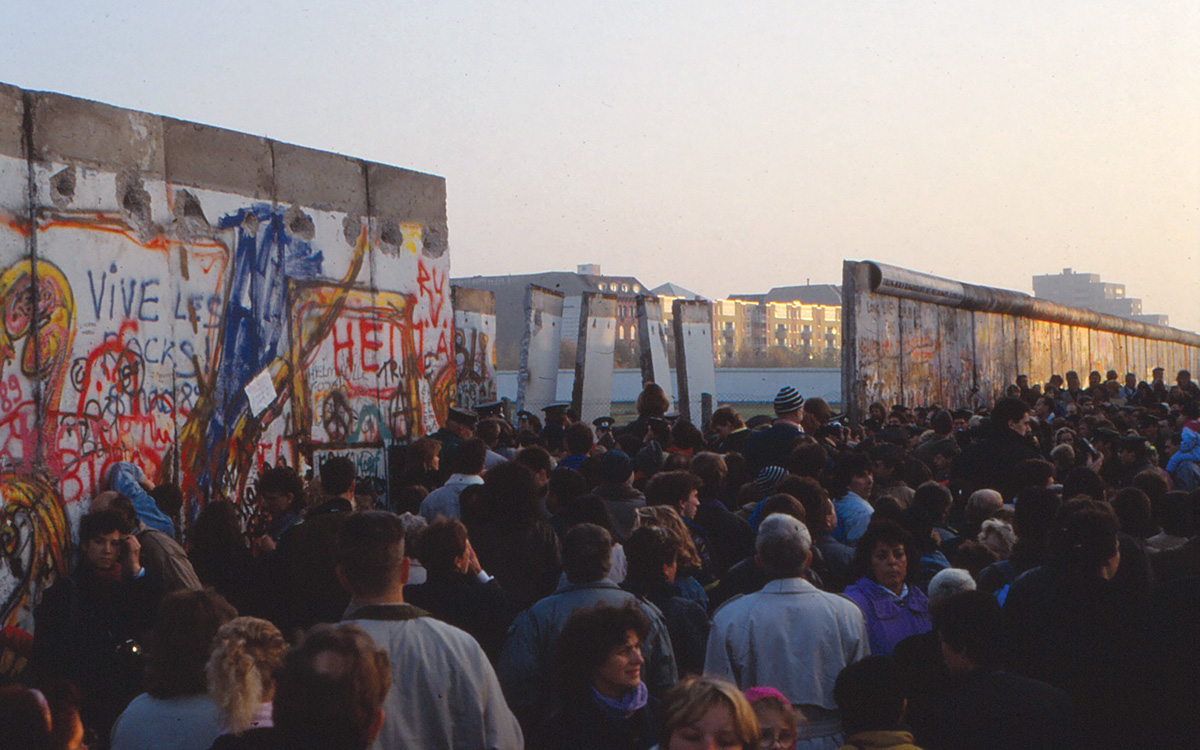
Berliners at the Berlin Wall as it is being dismantled.
Michael Hammer
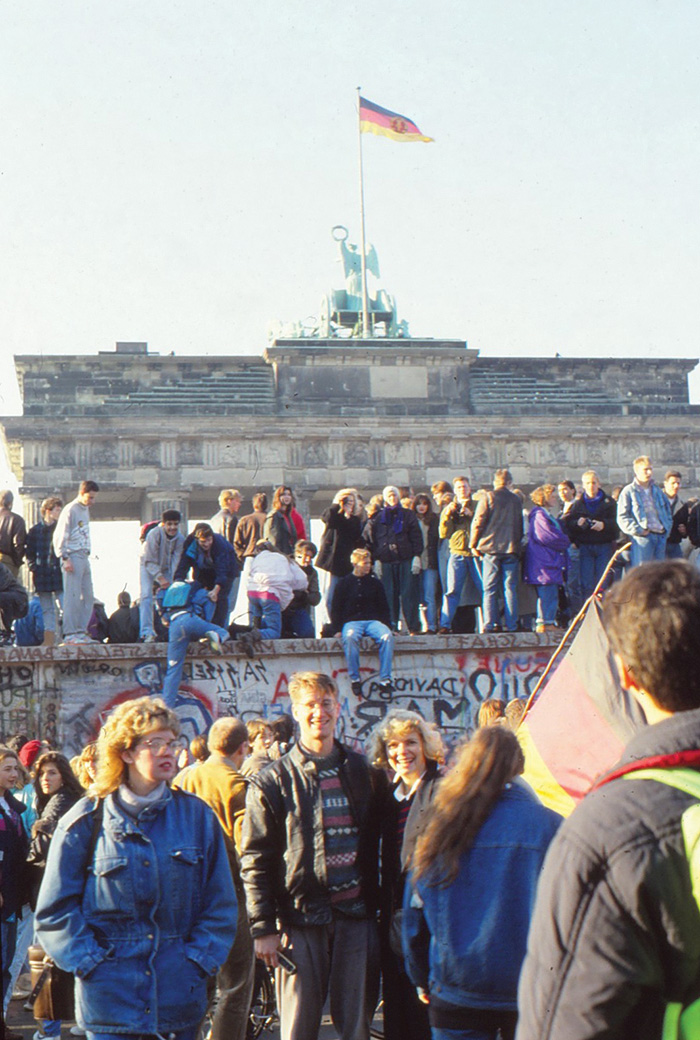
FSO Matt Bryza (center, in black jacket) and Margret Bjorgulfsdottir (spouse of Mike Hammer, next to Bryza) join Berliners in front of the Brandenburg Gate on Nov. 10, 1989, to celebrate the fall of the Berlin Wall.
Michael Hammer
Right Place, Right Time
Michael Hammer
West Berlin, Federal Republic of Germany
Thirty years ago, fresh out of A-100 and on our first tours, my classmate Matt Bryza was serving in Poznan, Poland, and my wife, Margret Bjorgulfsdottir, and I were in Copenhagen. Matt and I had been friends in grad school at Fletcher and were eager to get together. Since Matt was serving in Poland in the bad old Iron Curtain days, he frequently went to decompress in West Berlin, so we decided to meet up there over Veterans Day weekend in 1989.
Little did I know at the time that it would be one of the most momentous experiences in my 30-plus years in the U.S. Foreign Service.
The journey got off to an inauspicious start. On the train from Copenhagen to West Berlin, an East German border guard took my diplomatic passport, barked something unintelligible and disappeared. Having seen too many spy thrillers, I thought this was it, we would be whisked away in darkness. But instead, he simply returned with deutsche marks in hand to reimburse me for a visa fee I should not have paid as a diplomat.
Things got funky when we arrived at Berlin’s train station and there was no sign of Matt, who had made all the arrangements for our visit. With no cell phone or way to reach him, we just waited anxiously until he came running, screaming: “They are tearing down the wall, they are tearing down the wall!” My immediate thought was that Matt must have been drinking. But, lo and behold, as we approached the Brandenburg Gate, you could hear the pounding of hammers against that hideous wall.
Without much thought, two American diplomats joined the young West Berliners on top of the wall. The West Berliners were taunting the East German guards, jumping onto the east side and then climbing back up on the wall as the guards, machine guns in hand, approached them. Thankfully, the East German guards did not fire as they had been prone to do previously when East Berliners daringly tried to flee.
I recall the lengthy lines at automatic cash dispensers as East Berliners collected the 100 DM they were entitled to upon arriving in the West. At border crossing points you could see Trabant car after Trabant car among crowds of people walking into the West, many with joyful tears streaming down their cheeks. As we strolled the streets, we ran into perhaps the only German we knew, another Fletcherite. Overcome with emotion, he uncharacteristically hugged us. That is the kind of day it was.
On Nov. 11, we had planned a dinner in East Berlin with our ambassador to East Germany, Dick Barkley, who had been a mentor to our A-100 class—the Fighting 44th! We called him to say we would understand if dinner was off, but he insisted we come over as his wife, Nina, was already preparing dinner. We crossed through Checkpoint Charlie, and as we looked at the endless stream of people crossing to the West, we worried how my wife, then an Icelandic citizen, would get back to the West. After dinner Amb. Barkley had to excuse himself to appear on “Nightline” to discuss the dramatic events. We took that as our cue to leave.
We sensed that the opening to the West would be permanent when we reached Checkpoint Charlie and saw that now the lines were of East Berliners returning to their homes, with virtually no one crossing westward. That night, the stench of cheap champagne flowing through the streets of Berlin was the smell of freedom—and how sweet it was!
I will admit to an uncomfortable moment when I returned to Copenhagen and shared my slides with the embassy community. The deputy chief of mission stopped me at one of the slides—an unobstructed view of the Brandenburg Gate?!—and asked where the photo had been taken. I quickly moved to the next slide, not wanting to dwell on the imprudence of exuberant American diplomats risking an international incident by climbing on top of the wall in celebration.
Michael Hammer was a first-tour Foreign Service officer in Copenhagen, on a vacation in West Berlin when the Berlin Wall fell. He is currently serving as U.S. ambassador to the Democratic Republic of the Congo.
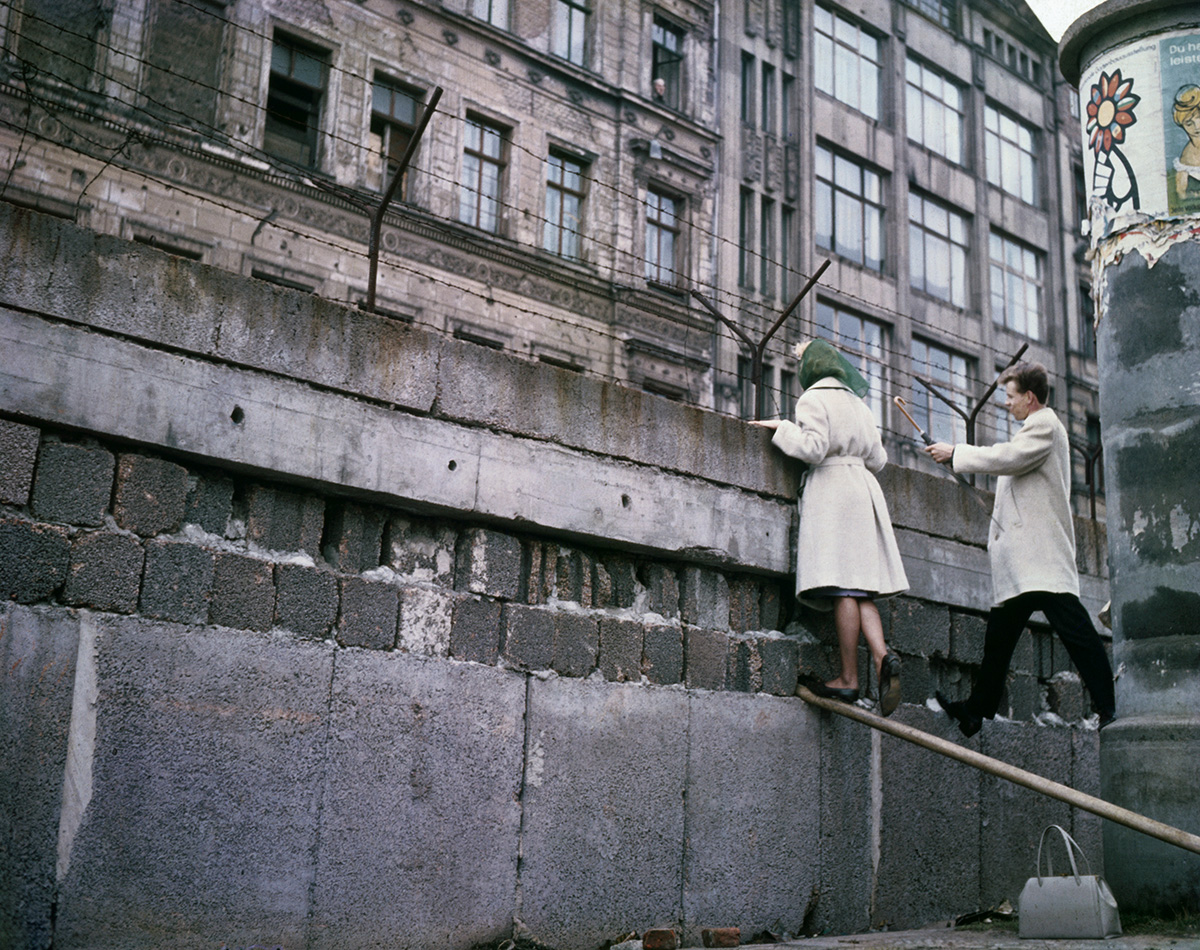
During the Cold War, a young West Berlin couple talks to relatives in an East Berlin apartment house (see upper window open). They have climbed to the top of the wall to have their brief conversation.
Getty Images / Bettmann
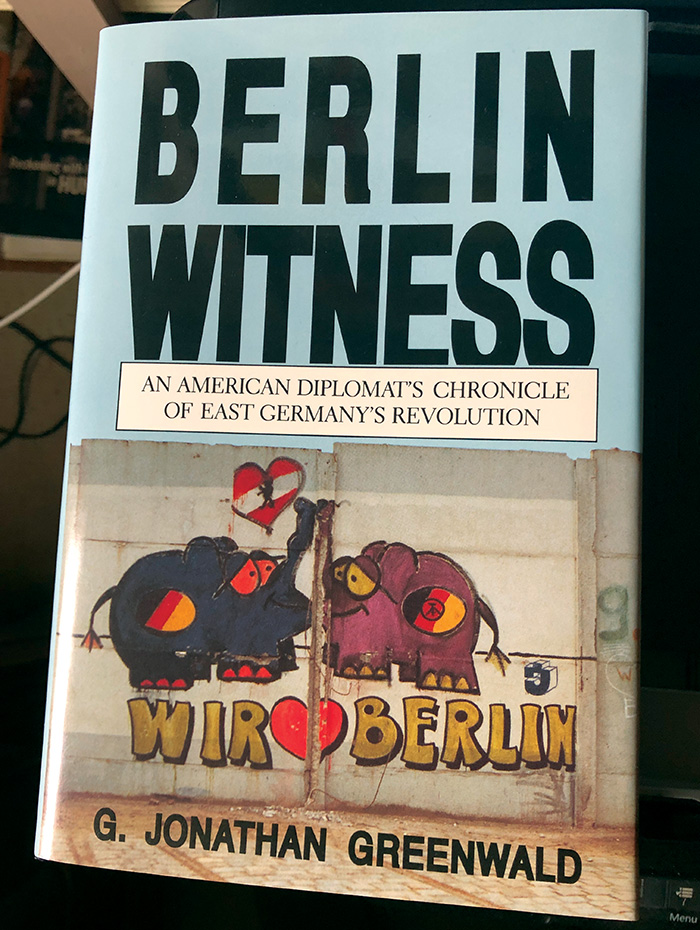
Jon Greenwald’s book, originally published in 1993.
Jon Greenwald
To Celebrate or Sleep?
Jon Greenwald
East Berlin, German Democratic Republic
As the embassy’s political counselor in East Berlin, I spent hours that evening telling colleagues in West Berlin and State’s Operations Center not to expect immediate drama. We had been working hard for months as peaceful revolution developed in the German Democratic Republic.
A few days before, a million people had demonstrated in the heart of the city for radical changes. All week we were reporting on the Communist Party plenum that revised the Politburo and introduced a reform prime minister. We were anticipating a law to permit extensive travel for East Germans for the first time since the Berlin Wall was built. As I coordinated reporting, I watched the televised press conference; the party’s spokesman, Guenter Schabowski, ended with a comment on new regulations that would allow applications for immediate travel.
My phone began to ring. Ambassador Dick Barkley had heard Schabowski and wanted us to inform Washington. Then the head of the U.S. mission in West Berlin [known as USBER], Harry Gilmore, called to say that the mayor had told him plans were ready, since Schabowski had advised him a week earlier to expect visitors soon.
“When will it begin?” Harry asked.
Schabowski said documents would be needed, I explained, though police offices would probably be swamped by applicants the next morning.
Imre Lipping, my deputy, arrived to compare notes. We agreed there were unanswered questions. There could be a long wait for passports, if only because millions would have to be issued. But if the authorities processed applications as promised, the question would arise what purpose the wall retained. Unless the GDR acknowledged it was becoming an anachronism, many would conclude liberalization was only a gambit that could be withdrawn as quickly as it was introduced.
When my wife, Gaby, a Berliner, arrived home, she recounted a troubling experience minutes earlier while returning from visiting her mother in West Berlin. As she left the checkpoint, a dozen men blocked the street. She first thought they were drunk but saw no bottles, and more people came out of apartment buildings, apparently to join them. I knew nerves were stretched tight and hoped the restraint that had carried East Germans so far would not fray just as their demands appeared close to realization.
Our embassy was empty except for communication officers Duane Bredeck and Larry Stafford when I handed in my cables and began to drive home to the Pankow district. Downtown was empty, though lights were burning at party headquarters. But at Schoenhauser Allee, in the shadow of the elevated train, thousands were streaming through the Bornholmer Strasse intersection. Police were struggling to keep a lane to Pankow open, but the crowd was intent on reaching the wall.
I was frightened for them and the peaceful process we had witnessed all fall. There were troops just a few hundred yards away. If Berliners did not wait for morning and demanded to be allowed through now, how would the young soldiers in the watchtowers react? Was there one panicky youth with a gun on either side of the barrier? Warnings that a violent incident could bring civil war were on my mind.
I considered joining the push toward the wall, but in that age without cell phones, it might be hours before I could reestablish outside contact. Better to continue home to put out my alert. Unusually, lights were on in many houses on our street. Ours, however, was dark. I woke Gaby, who stood anxiously beside me as I telephoned J.D. Bindenagel, the deputy chief of mission. Thousands are pushing toward the wall, I told him, and there may be trouble.
“It’s all over,” he replied. “They’ve opened the wall. I’ve spoken with Washington. Turn on your television.”
And so we saw the joyful scenes. Gaby, a student when the wall went up, had known it all her adult life. “I don’t believe it. I just don’t believe it,” she said, before asking, “Should I dress? Should we go downtown?” I wanted to, but it had been a long day, with a longer one starting in a few short hours.
So we went to sleep while Berlin celebrated, though we cried a bit first. And then our embassy began to report on the new Germany that was being born.
Jon Greenwald is a 30-year veteran of the U.S. Foreign Service. Since 2017 he has been working on a project to bring young Israeli and Palestinian students to study together for a three-year period at leading prep schools in the United States, Germany and Israel.
Managing from Moscow
Raymond F. Smith
Moscow, USSR
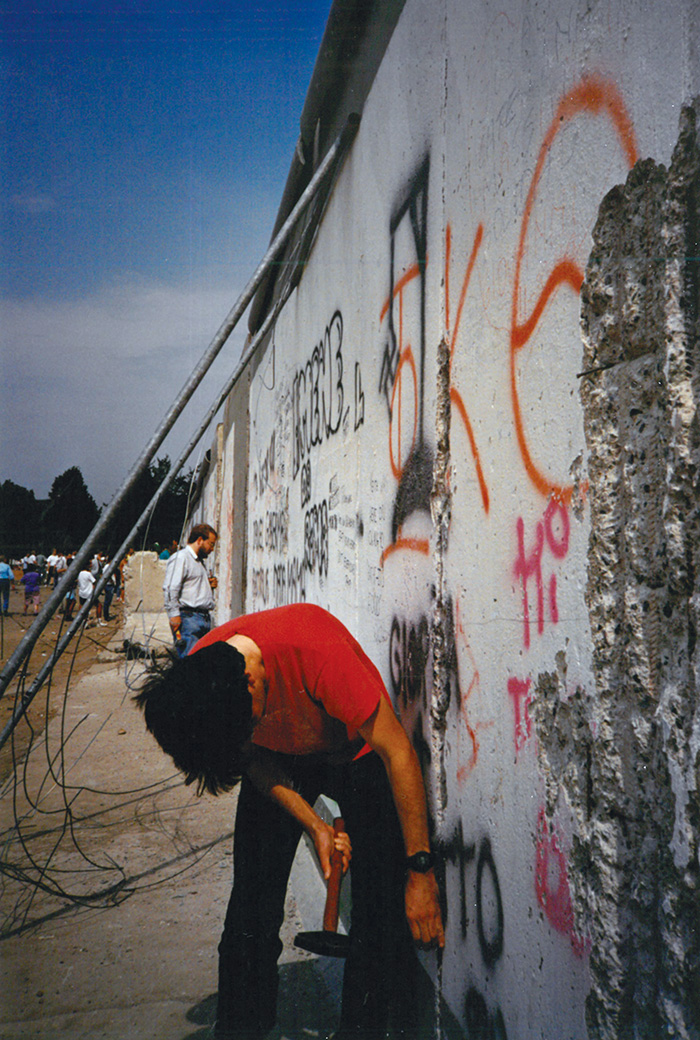
An American visitor chips away at the wall in an open Berlin, spring 1990.
Shawn Dorman
World-shaking events do not always occur on personally convenient timetables. If they had asked me, I’d have told the East Germans to pick a different week to tear down that damned wall.
It greatly inconvenienced me. You see, I was unofficially in charge of the U.S. embassy in Moscow at the time. I say unofficially because the ambassador was in the country, although on a visit to one of the Soviet Union’s far-flung republics. With the deputy chief of mission out of the country, I was filling in for both. But that was not the real inconvenience.
Rather, my wife was out of the country, our nanny was not in Moscow and I was working out of the DCM’s office with my 10-week-old son strapped to my chest in a baby pouch. My plans for the weekend included heating the reserve supply of breast milk to the proper temperature, changing diapers and, probably, getting precious little sleep. Not the best setup for trying to get information from the Foreign Ministry about Soviet views on the rapidly unfolding developments.
Of course, we were not going to get any immediate information out of the Foreign Ministry in any case, because on something like this no one would comment before Communist Party General Secretary Mikhail Gorbachev or Foreign Minister Eduard Shevardnadze did. There are times, though, when as a diplomat you know what a country is going to do. You know it because you have been there for a while, and you have what I can only call a “feel” for things—a combination of facts, firsthand observations and intuition that is almost unattainable from a distance. It is a resource that is, unfortunately, often undervalued at the political level.
Many of Gorbachev’s foreign travels during the prior year had been to Eastern Europe, where he told the Communist Party leaderships that they needed to reform, that if their people rose up against them, the Red Army would no longer intervene on their behalf. He meant it. The “new thinking” that he and Shevardnadze had made the cornerstone of Soviet foreign policy had as a principal tenet an end to what he called the enemy image of the West.
This was not just a slogan. It was essential to Gorbachev’s domestic reform effort, the basis for major cuts in Soviet defense spending that would free resources for domestic needs, improve peoples’ lives and solidify support. None of that worked out in the long run, but there remained a lot of optimism for it in 1989. Intervention would have meant the end of the reform effort; he would not allow it as long as he remained in power.
On the Monday after the fall of the Berlin Wall, the vast majority of East Germans who had crossed returned home to work. The Soviet leadership breathed a sigh of relief. Russians fear chaos, but the only explosions they had seen were of joy. The end of the wall was a fait accompli, the disintegration of the East German regime a probability. In the coming months, Gorbachev and Shevardnadze would seek to turn this situation to their advantage by trying to negotiate an end to their no-longer-tenable position in Germany in return for aid and Western acceptance.
The seeds of our current problems with Russia were planted in those negotiations, but that is a matter for a different discussion.
Raymond F. Smith, who was in Moscow when the Berlin Wall fell, was a Foreign Service officer from 1969 to 1993. A longtime international negotiations consultant, he is the author of Negotiating with the Soviets (1989) and The Craft of Political Analysis for Diplomats (2011).
Predicting the Fall
George F. Ward Jr.
Bonn, Federal Republic of Germany
When East Germans began streaming to the West through the Berlin Wall on Nov. 9, 1989, I was deputy chief of mission at the embassy in Bonn. The events of that day set in motion a swift process that led to the unification of Germany on Oct. 3, 1990.
The fall of the wall came as no surprise to Ambassador Vernon A. “Dick” Walters. On April 7, 1989, while preparing for his assignment to Germany, Walters had asked me to be his deputy. At the beginning of our conversation, he said, “George, we’re going to Germany at a very interesting time. The Berlin Wall’s going to come down.”
At the time, this was an astounding statement, and I was skeptical. The conventional wisdom ascribed to by some of the State Department’s Germany experts and by a number of West German political leaders was that German unification would take place only over an extended period of time, through a convergence of the systems in East and West. Walters had a broader vision and a different view. The Soviet Union had suffered a defeat in Afghanistan and was weakened economically. General Secretary Gorbachev, Walters reasoned, would not use the Red Army to quell the popular unrest that was bubbling just below the surface in East Germany. Therefore, German unity seemed plausible, even predictable.
The geopolitics of German unity were worked out through the Two Plus Four negotiating process, which involved the four World War II Allies—the United States, the United Kingdom, France and the Soviet Union—plus the two German states. The embassy in Bonn supported this process but found its principal role in helping to wind down the special status of the four powers in Germany.
The sovereign status of the four powers was most evident in Berlin, but it also provided the basis for many institutions and activities throughout Germany, including the stationing of NATO forces and even the right of the United States to occupy the embassy complex in Bonn. Along with many other members of the embassy and mission in West Berlin, I was involved in quite a number of formal and informal negotiating processes. All of this unfolded at a dizzying pace, and the outcome was unclear until close to the end.
For me personally, German unification brought the joy of family unification. My grandmother had emigrated from Saxony to New York early in the 20th century.
–George F. Ward Jr.
The most consequential negotiation concerned the future status of the more than 200,000 U.S. military personnel and tens of thousands of other NATO troops in a unified Germany. For a while, some negotiators on the West German team maintained that members of NATO forces would be restricted from entering the territory of the former East Germany, perhaps even on personal travel. Although the Allies had no intention of establishing bases in the former East Germany, the proposed travel restrictions were unacceptable.
In addition, German proposals to subject Allied military personnel and their families to German law in a number of mundane areas would have posed substantial inconvenience. It is a tribute to the excellent German-American relationship that had been built up during the years since World War II that these and other questions were resolved through frank but amicable dialogue in time for German unification.
Embassy Bonn’s role in the German unification saga was best summed up by words included in the group honor award it received: “a classic example of successful American diplomacy, in which intelligence, energy, dedication and a clear understanding of U.S. interests combined to produce results beyond expectations.”
For me personally, German unification brought the joy of family unification. My grandmother had emigrated from Saxony to New York early in the 20th century. When the Berlin Wall came down, I was able to establish contact with relatives in the East. Visiting with them in their workers’ apartment in Halle brought both joy and sadness—joy over discovering family I had never known, but sadness about the grim conditions they had endured since 1945.
Later, I was able to bring my relatives to Bonn for a tearful, cheerful time with my mother, who was visiting us. Our happy walks along the Rhine made me thankful for the work and sacrifices of so many that resulted in a good end to the Cold War.
The deputy chief of mission in Bonn in 1989, Ambassador George F. Ward Jr. was a Foreign Service officer from 1969 to 1999. Since retiring, he has served in leadership roles at the United States Institute of Peace, World Vision and the Institute for Defense Analyses.
How I Became a Mauerspechte
Edwina “Eddie” Sagitto
Heidelberg, Federal Republic of Germany
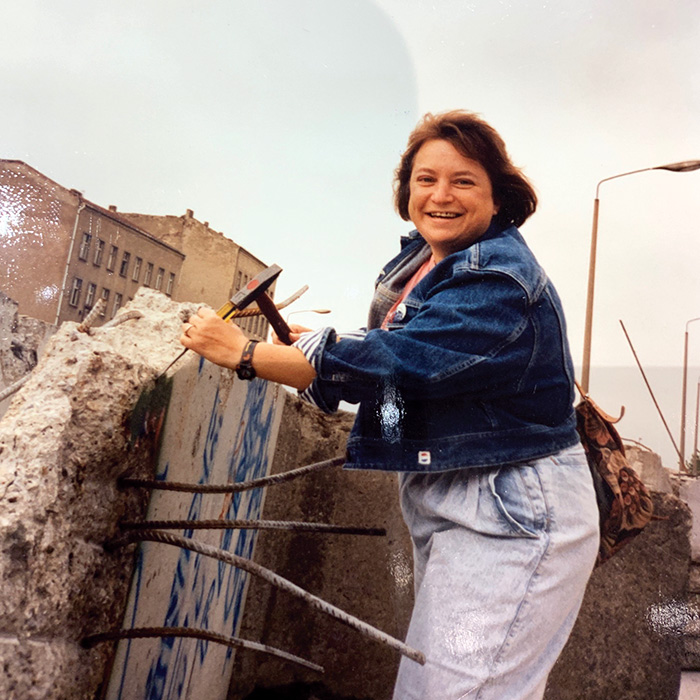
Eddie Sagitto at the Berlin Wall.
Courtesy of Eddie Sagitto
In November 1989 I was living in Heidelberg, working as a management analyst for U.S. Army Europe (USAREUR). On Nov. 9, while visiting the German family of my partner in the Bavarian city of Neu Ulm, we heard the news that the Berlin Wall had fallen. I was ecstatic, but my German hosts didn’t seem impressed.
I wanted to experience the change firsthand, so the following weekend I went to Berlin. The mood was euphoric, but the huge crowds were gone. It was easy to access the Berlin Wall and soak in the atmosphere. There was a lively trade going on in pieces of the wall chipped off by enterprising kids known as mauerspechte, a slang word meaning “wall peckers.” Some were spray-painting parts of the wall before breaking off pieces to make them more saleable. I decided to chop off my own. It was not too difficult because the wall was made of porous concrete, and I amassed a whole bag full of chunks.
Things seemed to change quickly in the weeks and months that followed. Less than a year later, on Oct. 3, 1990, West and East Germany reunited. Some of the early enthusiasm in the west diminished as the costs of reunification became clearer. The U.S. military presence also changed, as the number of U.S. military personnel stationed in Germany (and the German and U.S. civilians working with them) dropped drastically.
For me, the fall of the Berlin Wall also opened up the possibility of travel to Eastern Europe. In 1991, after quite a bit of preparation, I went to Romania in hope of adopting a child. I traveled with a colleague and friend who also wanted to adopt. With the help of a translator and advice from others who had successfully adopted, we were both able to adopt, I a daughter and she a son.
In 1995 I joined the Foreign Service and had assignments in Slovakia, Croatia, Bosnia and Herzegovina, and Romania. The events of November 1989 not only had a profound effect on Germany and Europe, but on the direction my own career and life have taken.
Edwina “Eddie” Sagitto joined the Foreign Service in 1995, serving until 2013 as a public diplomacy officer. Since retiring, she has taken WAE assignments in Africa and elsewhere, and divides her time between Munich, Germany, and Phoenix, Arizona.
View from the Velvet Revolution
Thomas N. Hull
Prague, Czechoslovakia
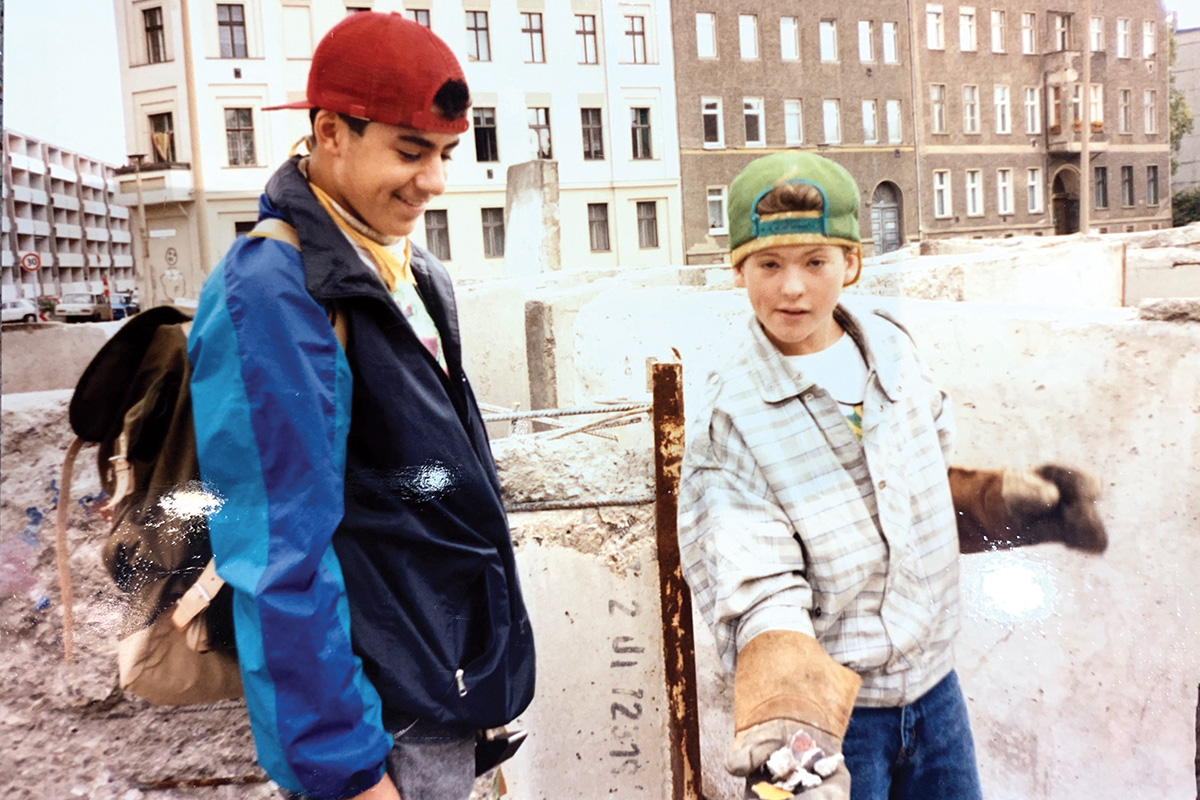
Two young mauerspechte sell pieces of the wall.
Courtesy of Eddie Sagitto
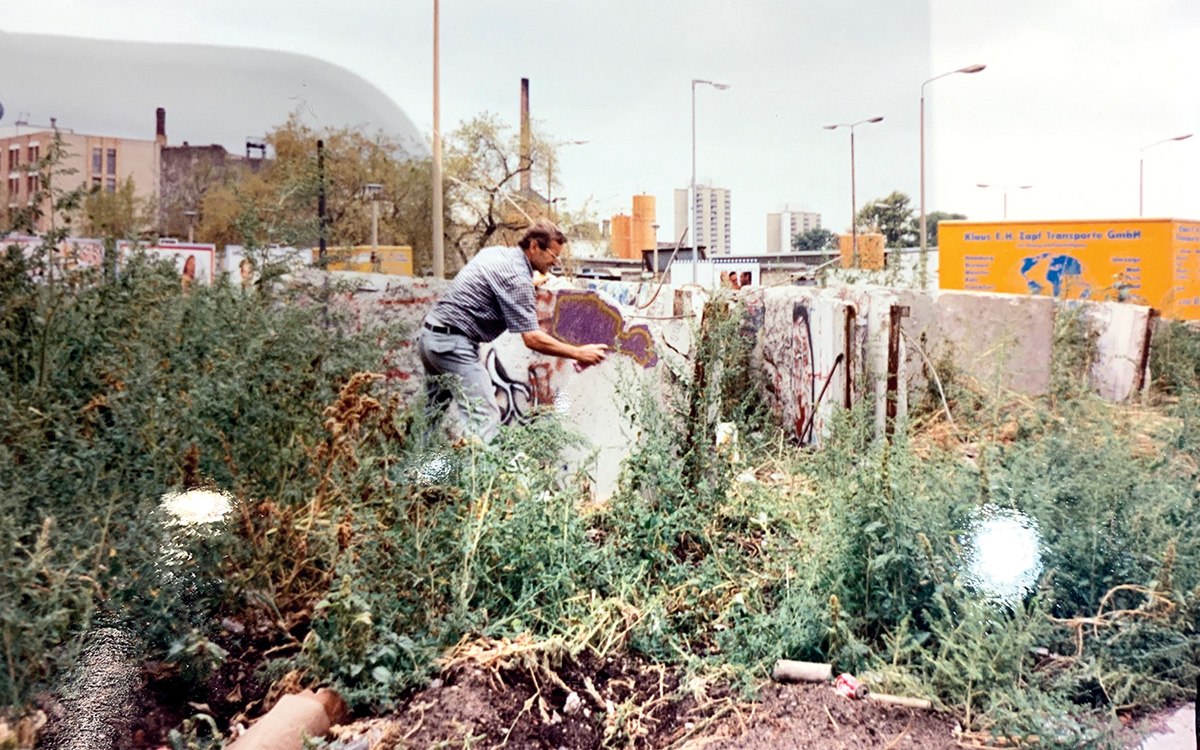
An enterprising individual spray-paints part of the wall for later sale.
Courtesy of Eddie Sagitto
When I left Washington in August 1989 to be a public affairs officer in Prague, conventional wisdom was that communism would collapse in Czechoslovakia before East Germany. Ambassador Shirley Temple Black arrived a week later, fully prepared to maintain our strategy of encouraging dissidents, promoting human rights and opposing communism, as had generations of American diplomats before us.
Within a month, a seismic upheaval began when East German refugees crossed the open border with Czechoslovakia in growing numbers to claim asylum at the West German embassy neighboring our embassy. Disoriented refugees scaled the U.S. embassy’s security wall and were redirected over the adjacent German wall. The West German embassy overflowed, forcing thousands of asylum seekers to live on the cobblestone street in front of our embassy for weeks. The crisis focused world attention on Prague until October, when trains took the refugees to West Germany via East Germany. Berliners then increased pressure to eliminate travel restrictions to the West, which culminated in the fall of the Berlin Wall on Nov. 9.
In Prague the Czechs were slower to react. Although the resolution of the refugee crisis showed that Mikhail Gorbachev would not oppose freedom, the Prague populace, remembering how the Soviets violently crushed the 1968 Prague Spring, remained uncertain. A police assault on a Nov. 17 student demonstration finally sparked a mass reaction. Dissidents and intellectuals, most of whom were close embassy contacts, formed the Civic Forum to lead the Velvet Revolution.
After demonstrations of up to 500,000 protesters spread, the communist leadership resigned on Nov. 24. By the end of December, dissident dramatist Vaclav Havel was president, and deposed Prague Spring leader Alexander Dubcek was resurrected as president of the National Assembly.
The atmosphere changed immediately. The secret police removed their hidden cameras and listening devices from my apartment. Soon thereafter, I found myself on stage congratulating Czechoslovakia for its revolution in front of President Havel and 20,000 fans at a nationally televised concert.
Our strategy quickly shifted to nurturing democracy and transforming the Czechoslovak economy. Our activities were limited only by sparse budgets and our minimal American staff, who worked 14-hour days, sometimes longer, seven days a week for months on end. Although resources eventually increased in all embassy sections, workloads also grew exponentially.
Czechoslovakia immediately became a magnet for visitors. Ten senators and 56 representatives came in the first two months. Some had real public diplomacy value, such as House Majority Leader Richard Gephardt, who spoke on democracy to Charles University law students. Secretary of State James Baker and Supreme Court Justice Anthony Kennedy also addressed students.
We shamelessly recruited private visitors as well. Most memorably I arranged directly for rival media moguls Katharine Graham and Rupert Murdoch to dine together with Ambassador Black and me for a discussion with prominent Czechoslovak women on their role in the new democracy.
The ultimate visitor was President George H.W. Bush, who announced to 200,000 people in Wenceslas Square that the Lenin Museum would become the American Cultural and Commercial Center. The Czechs understood the significance—this was the building where Lenin established the Bolshevik party in 1912, setting a course that culminated in the Cold War.
Another consequence that commanded our attention was the rise of Slovak nationalism. The American consulate in Bratislava reopened. At the ribbon-cutting we reunited Senate Foreign Relations Committee Chairman Claiborne Pell, who had been our last consul general in Slovakia, with his Foreign Service National assistant, Lubomir Elsner, who had disappeared in 1952 and spent 11 years as a political prisoner.
As our resources grew, we brought legal experts to Bratislava, including California Assistant Attorney General Adam Schiff, now chair of the House Select Committee on Intelligence, to advise Slovak leaders. Despite our best efforts, Slovak nationalism eventually produced a velvet divorce between the Czech Republic and Slovakia.
These recollections merely give the flavor of our diplomatic activities and accomplishments in response to communism’s demise. The Foreign Service performed magnificently with extraordinary dedication throughout the Velvet Revolution. This was recognized by Ambassador Black, who presented us each with a pewter mug engraved to “Team ’89 Veterans” as a memento of her appreciation when she departed post in 1992.
Ambassador Thomas N. Hull was a public affairs officer in Prague in 1989. In retirement he has been Warburg Professor of International Relations at Simmons University in Boston and president of Foreign Affairs Retirees of New England. He lives in Grantham, New Hampshire.
What Would Austria Do?
Robert F. Cekuta
Vienna, Austria
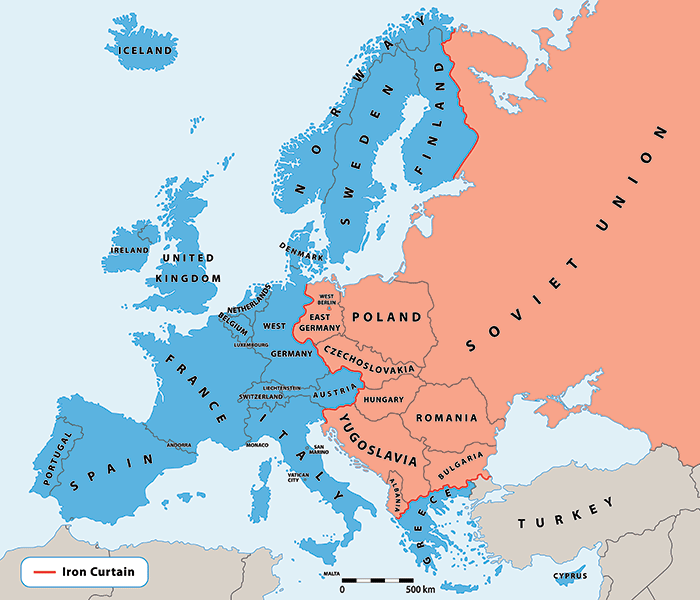
Cold War Europe.
Peteri / Shutterstock.com
The U.S. embassy in Vienna in 1989 was a key post for monitoring the changes that were underway in the Warsaw Pact. In the economic section where I worked, prime concerns included East-West trade—i.e., the levels, the composition and the actors in trade and investment between the West and communist countries—as well as the control of exports of Western dual-use and other sensitive goods and technologies.
We frequently met with Austrian bankers and others doing business in the East for their view of the economic situations in those countries, as well as to get insights into the reform processes and how the West might support an economic and political transformation. Austria’s media, building on traditional ties and the country’s post-1955 neutrality, were useful sources; Austrian journalists in Prague, Budapest, Berlin, Moscow and elsewhere reported daily in detail on the political dynamics and democratic aspirations in each capital. We also monitored the public’s hope and confusion over how events in the East were unfolding.
The relative relaxation of Hungary’s border controls had brought influxes of Hungarians and, later, East Germans into Austria. East Germans tended to drive through to West Germany, while Hungarians and others came for weekend shopping along Vienna’s Mariahilfer Strasse, buying appliances, housewares and other Western goods that were in short supply at home. The Austrians welcomed the Eastern Europeans, seeing their visits as positive signs of a relaxation of communist totalitarian controls and of a possible return to a prewar Central Europe.
It was a shock that Friday night when we found out the Berlin Wall had fallen, and questions about what it all meant followed. My wife and I heard the news from a German friend whose brother lived in West Berlin. Though unclear about what exactly was going on, his excitement matched the mood in Vienna that weekend. Younger Austrians were euphoric. Viennese of all ages lit candles and said prayers of thanksgiving in the city’s numerous churches. The end had come peacefully, bringing hope for the people in the communist East and a sense that this opening in Berlin would assure them all a better future.
The opening of the wall and the sudden ability of East Berliners to travel to the West was a strong sign for the public that Mitteleuropa, the Central Europe that Austrians looked on as a lost cultural and economic entity, could now become a reality again. Certainly many Austrian bankers and business people saw great potential for investment and economic expansion.
However, at the same time, memories of Hungary in 1956 and Czechoslovakia in 1968 led to caution and concern that the Soviets might again clamp down hard. Also, in early November 1989, there was no certainty that Prague, Sofia, Bucharest or Tirana would tolerate democratic reforms. In Vienna, initial jubilation evolved into a cautious optimism tempered by years of dealing with the Soviets and the region’s other communist states.
As the permanence of the opening and changes in the East became apparent, the number of American businesspeople coming through Vienna grew markedly, and Austria’s government and business community sought to remake Vienna as the center for economic activity in the Danube Basin. With the understanding in the East that democracy and prosperity were connected, conferences and delegations focused on what was necessary to establish free-market economies with enterprises that could compete regionally and globally.
Questions about the reunification of Germany and its implications for Austria also arose, including what it might mean for the European community if Austria joined, as it hoped to and indeed soon would. Other European governments even raised what now seems an outlandish concern: that Austria might unify with Germany.
My tour in Vienna ended in 1992. The political, economic and social changes were well underway and becoming institutionalized, notwithstanding the growing trepidation within Austria about refugees and illegal immigrants coming from the East. The overall sense was of gratitude that the wall was gone; now our work had to be realizing the opportunities for the new Europe.
An economic officer in Vienna in 1989, Robert F. Cekuta retired from the U.S. Foreign Service in 2018 after serving as U.S. ambassador to Azerbaijan. He now divides his time between Washington, D.C., and Jefferson, Maine.
A Study in Change
Margaret K. McMillion
Washington, D.C.
In 1989, I was a member of the Class of 1990 at the National War College. We began the year firmly set in the Cold War. Our first reading assignment, John Lewis Gaddis’ Strategies of Containment, set the stage for the next 10 months.
Change, though, was in the air. In the Soviet Union, Mikhail Gorbachev was promoting glasnost and perestroika. Vietnam and Laos had initiated market reforms known as New Thinking and the New Economic Mechanism (Doi Moi and Chintanakhan Mai). Yet events at Tiananmen Square that June had shown the limits of reform in China.
Throughout the fall of 1989, our class watched with wonder as the pace of change accelerated in Eastern Europe. A Solidarity-led government took power in Poland in late August. Hungary and Czechoslovakia allowed “holidaying” East Germans to travel on to Austria and take refuge in West Germany. The East German government agreed that citizens seeking asylum in Budapest could go by train to West Germany. Following protests in Leipzig, General Secretary Erich Honecker resigned. On Nov. 9, the East German spokesman announced (inaccurately, we later learned) that citizens could leave by any border crossing. Guards opened the checkpoints between East and West Berlin, and the Berlin Wall was gone.
The challenges are many, but the opportunities have never been greater.
–National War College Class of 1990 Yearbook
More was to come, and the evening news brought new developments every day: in Bulgaria, Czechoslovakia and, ultimately, Romania, democratic governments assumed power. For me, one of the most memorable events was the invasion of the East German Stasi offices in Erfurt in January 1990. An incredulous CBS correspondent stood amid flying paper and demonstrators who were determined to stop the remaining officials from destroying their files, which today are declassified. Among the military officers in the class, there was a palpable sense of relief that they were unlikely ever to fight a war in Europe.
These events had an immediate impact on our academic program as we began to discuss a possible “peace dividend” and “new architecture” in Europe. Faculty member Stephen Szabo told USA Today that students faced a situation comparable to the fast-moving events at the end of World War II. His suddenly popular area studies class on Eastern Europe and the Warsaw Pact, which I took in preparation for a spring field trip to Poland, Czechoslovakia and Austria, focused more on political and economic reform than military doctrine. By the time the course concluded in April, the Warsaw Pact was becoming a relic of the Cold War. It would later be dissolved.
The yearbook staff decided that change was the only possible theme. The winds of change were also blowing elsewhere, especially in South Africa where Nelson Mandela walked free in February and Namibia became independent in March. We wrote in the foreword: “The challenges are many, but the opportunities have never been greater.” Two pages provided a chronology of a memorable 10 months in world affairs.
It was an exciting time, disorienting in many ways, but filled with hope about the possibilities for building a more peaceful and prosperous world.
Margaret K. McMillion was U.S. ambassador to Rwanda from 2001 to 2004. In 1989 she was studying at the National War College in Washington, D.C. Ambassador McMillion currently resides in Bangkok.
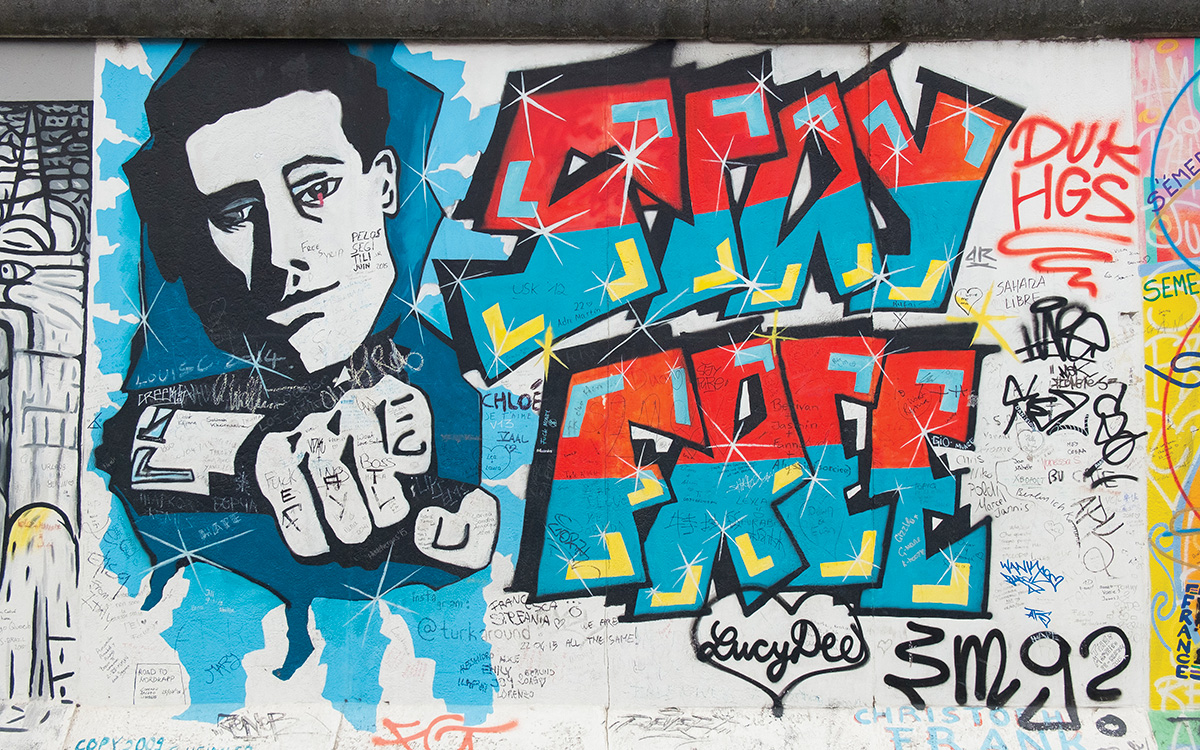
Graffiti on the longest-remaining section of the Berlin Wall, featured at the open-air East Side Gallery, Berlin, 2015.
James Talalay
In the Airport with Walesa
John J. Boris
Warsaw, Poland
The Berlin Wall had just fallen, and Lech Walesa was heading to the United States.
Those of us serving in Warsaw, Krakow and Poznan in 1989 had front-row seats as Solidarity, the free trade union, through negotiations, activism and elections, outmaneuvered the Polish United Workers’ Party (i.e., the communists) into the step-by-step surrender of its power. As the deputy to the political counselor at Embassy Warsaw since July 1988, I had lucked into the exceptionally interesting role of maintaining working-level contact with the trade union, a job that brought regular interaction with some of Solidarity’s most eminent figures, such as Adam Michnik, Bogdan Lys and, at times, even Chairman Walesa himself.
When President George H.W. Bush visited Poland in July 1989, I was the site officer for the home-cooked lunch at which Lech and his wife, Danuta, hosted the president and first lady. By the time I escorted the fourth congressional delegation—a total of 21 members over the course of 18 days in August 1989—to Gdansk, the union leader and I were simply nodding at each other in greeting. That presidential visit, and the wave of visiting legislators, led to invitations for Walesa to visit the White House and address a joint session of Congress. Walesa and his party were planning to fly out of Warsaw on Friday, Nov. 10, and several of us from the embassy planned to use that Veterans Day holiday to see them off.
I was washing my breakfast dishes that morning as the BBC World Service reported that, late the previous evening, the East German authorities had lifted border controls. The Berlin Wall had fallen. I teared up. Poland had seen a succession of evermore remarkable “Is this really happening?” developments over the course of the year, but even by those standards, this news was breathtaking.
That is certainly how the Solidarity delegation in Warsaw’s Okecie airport departure lounge viewed things. “Nie do wiary!” (Unbelievable!) averred Krzysztof Pusz, Walesa’s aide-de-camp and one of my closest contacts, as we exultantly greeted each other. Ambassador John Davis and his spouse, Helen Davis—a savvy diplomatic presence in her own right—were engaged in conversation with a beaming Walesa. I could not hear what they were saying, but it was not hard to read the trade union leader’s mood. Indeed, all of us in the departure lounge were quietly or giddily incredulous. Walesa’s upcoming Nov. 15 address to a joint session of Congress had just taken on even greater significance.
In 1989, before Poland’s market reforms had kicked in, it was common for Embassy Warsaw personnel to make several shopping runs a year to U.S. military facilities in West Berlin. By a happy coincidence of timing, my wife and I had scheduled one beginning on Nov. 13. Within days of the fall of the Berlin Wall, Anne and I were outside the KaDeWe (Kaufhaus des Westens, a department store), gaping at the Trabants full of people gaping back at us.
John J. Boris joined the U.S. Foreign Service in 1980. He was the deputy political counselor in Warsaw when the Berlin Wall fell. Mr. Boris lives in Annandale, Virginia.
Europe Changed, But Africa Didn’t
Mark G. Wentling
Lomé, Togo
Lomé, on the west coast of Africa, is a long way from Berlin. Yet when the Berlin Wall came down in November 1989, the repercussions were felt in Togo and other countries in Africa, where people were struggling to overthrow dictators and establish multiparty democracy. We all thought the fall of the wall marked the end of the Cold War, and we believed that a huge peace dividend was just around the corner.
I was USAID’s representative for Togo and Benin, based in Lomé, at the time. Violent protests against the dictatorial regime in power for 22 years were frequent. The people had had enough of an authoritarian one-party system and wanted a democracy that reflected their hopes for a better future. The dismantling of the Berlin Wall raised their hopes of achieving lasting democratic change; it strengthened their case and the justness of their cause.
We thought the end of Cold War politics would mean an end to the superpower alliances in Africa, where superpowers would vie for client countries in the region, often propping up bloody and corrupt national regimes. For example, U.S. foreign aid was often lavished on those African countries that were staunch opponents of communism, despite the despicable acts of their autocratic rulers.
We believed that in a post–Cold War era, the United States could determine its level of assistance to African countries without applying international political considerations. It could also decide more clearly what its strategic interests in each country were beyond providing humanitarian assistance.
The fall of the wall thus gave renewed hope to Togo and other African countries. Sadly, in Togo’s case, these hopes were shattered, and the promise never realized. Togo’s dictator, Gnassingbé Eyadéma, who stayed in power for another 16 years until his natural death in 2005, was replaced by his son. The legacy of Gnassingbé Eyadéma proved far more powerful for Togo than the collapse of the wall.
In hindsight, the fall of the Berlin Wall 30 years ago has had little, if any, consequence for Africa—or for my lifelong pursuit for the betterment of this vast continent. There are still many critical “walls” of injustice and poverty to break down in Africa.
Retired FSO Mark G. Wentling joined USAID in 1977 and was serving in Togo when the Berlin Wall fell. His work and travels over the past 46 years have taken him to all 54 African countries.
It Couldn’t Possibly Happen Here
Kay Kuhlman and Brian Flora
Bucharest, Romania
In November 1989 we were serving in Bucharest. Brian was head of the political section, and Kay was the commercial officer. The Romanian government suppressed all news of the Berlin Wall’s demise, but we in the embassy were aware of Eastern European developments from cable reporting and Voice of America broadcasts.
And we were envious. The region was opening up, and there we were in a country seemingly stuck tight under the thumb of despot Nicolae Ceausescu and his Securitate goons. Even next-door Bulgaria, in those early days of November, joined the revolutionary movement and ousted Communist Party leader Todor Zhivkov.
Brian believed that street demonstrations would not be enough to overthrow the Ceausescu regime because the dictator would not hesitate to use deadly violence against his own people. Kay remembers telling some U.S. government visitor to Bucharest that, regrettably, it didn’t look like Romania would follow its Eastern European neighbors anytime soon.
Brian had limited contact with political dissidents in the capital (it was technically illegal for them to talk to us without written permission from the Securitate), but most of the mid-December opposition activity in Romania was centered in Timisoara and other locales distant from Bucharest.
We did not anticipate that just six weeks after the fall of the Berlin Wall, Romania would follow suit, going down in the record books as the only country in Eastern Europe whose people freed themselves through a shooting war in the streets. (Our experiences during those scary, but ultimately heady, December days is a story for another time.)
Retired FSOs Kay Kuhlman (Foreign Commercial Service) and Brian Flora (State) live in Oak Park, Illinois.
“That Is the End”
John W. “Jack” Bligh Jr.
Koenigswinter, Federal Republic of Germany
My wife and I were watching West German TV at our home in Koenigswinter, across the Rhine from the embassy, when the images of East Germans coming through the wall were shown. Was I surprised? Most certainly, especially by the spontaneity and lack of bloodshed.
In the following days, my job brought me into contact with a number of West German business leaders, several of whom said that they had never expected to see in their lifetimes any freedom of movement through the barrier. I like to think that I saw a tear or two in the eyes of some.
For a time after the opening, one might see an East German Trabant car abandoned beside the autobahn, probably because the fuel mix it required was not available in the Federal Republic. The magnitude of their owners’ joy at their newfound freedom is even clearer when one considers that they had waited for up to 17 years to buy a car.
The impact on my work was not overnight, but we would soon add constituent-post commercial operations in Berlin and Leipzig, and a lot of our commercial section and country team efforts went into ensuring that American companies would have a fair shot at the privatization of state-owned companies in the East.
Not many saw the days leading up to Nov. 9 as the beginning of the end of the German Democratic Republic, but at least one did. On a Monday in October 1989, before the wall fell, I had accompanied Ambassador Vernon Walters to West Berlin. (Mondays were the days of the Wir sind das Volk—We Are the People—demonstrations in East German cities, especially in Leipzig.) The ambassador, our minister in West Berlin, Harry Gilmore, and I were guests at a dinner hosted by West Berlin Mayor Walter Momper.
During that dinner, an aide came in and whispered something to Mayor Momper, who arose and announced that the East German military, which had been prepared for confrontation, had not fired on or interfered with the demonstration in Leipzig. I was seated next to Momper’s predecessor, Eberhard Diepgen, who said: “That is the end of the GDR.”
John W. “Jack” Bligh Jr. was a Foreign Service officer from 1966 through 1996. He was serving as the Minister Counselor for commercial affairs in Bonn when the Berlin Wall came down. He lives in Manlius, New York.
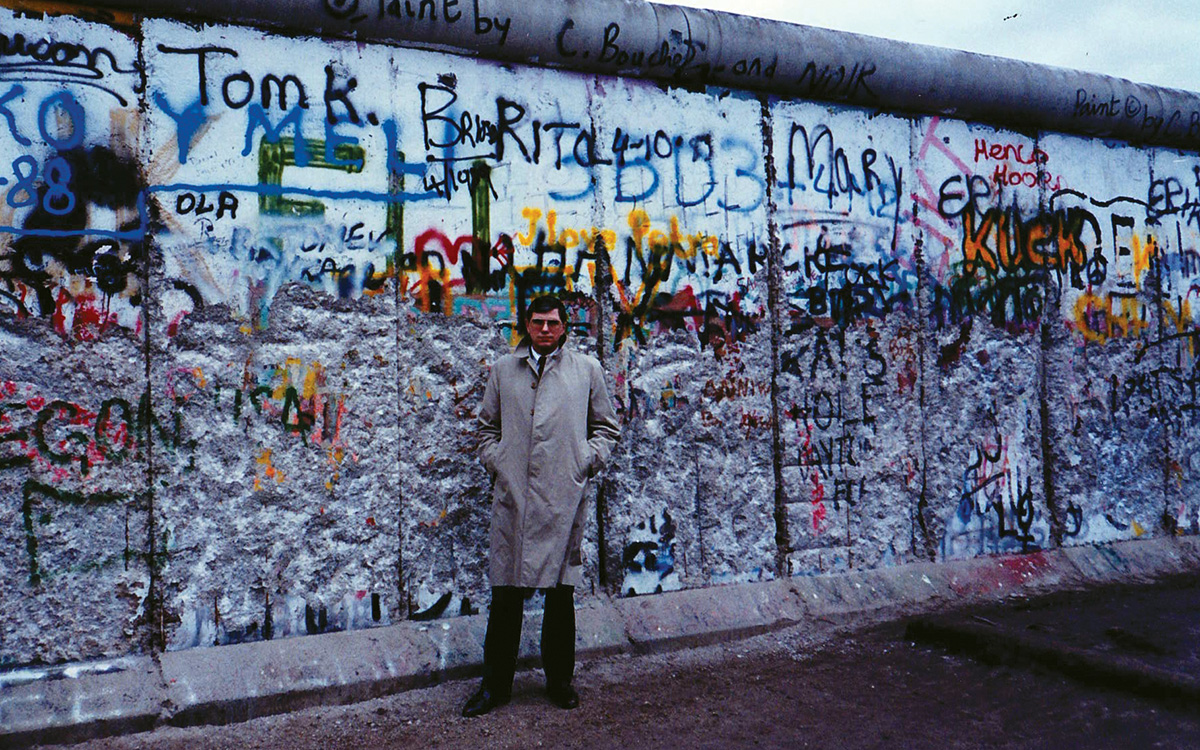
FSO Greg Suchan (above) and his wife, Susanne (below), at the Berlin Wall in December 1989.
Courtesy of Greg Suchan
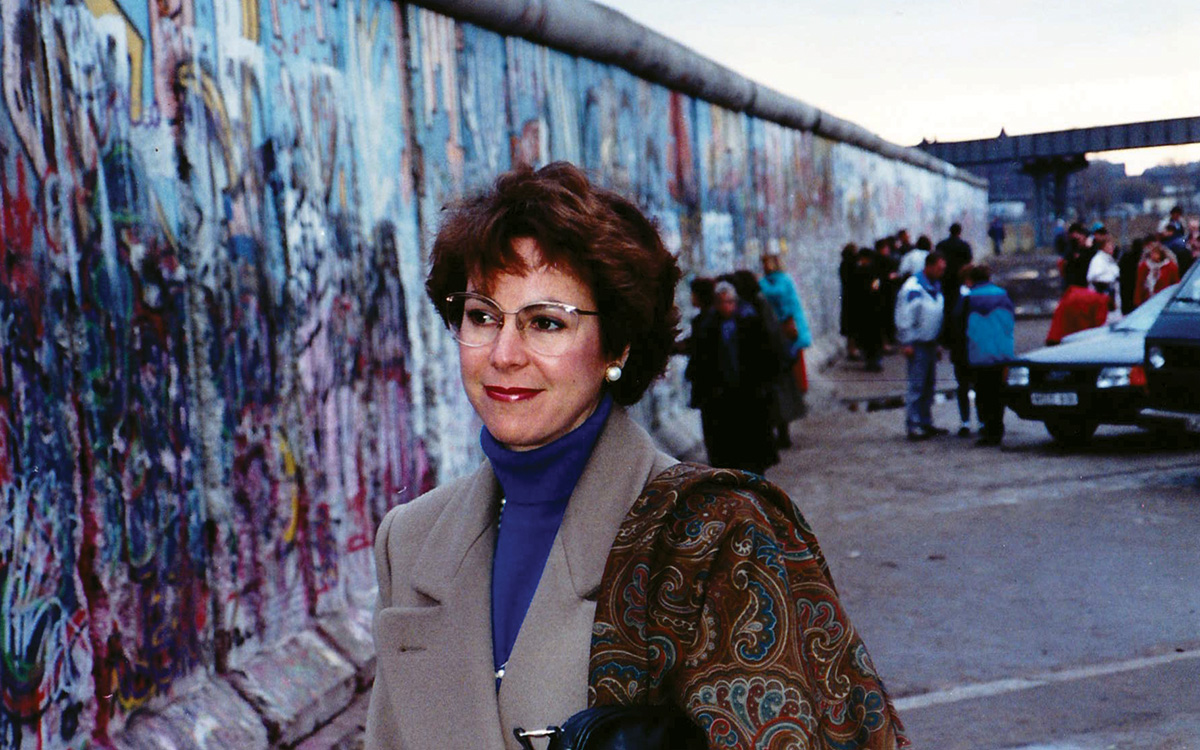
Courtesy of Greg Suchan
My Piece of the Wall
Greg Suchan
The Berlin Wall
In the autumn of 1989, I had just finished two years as the pol-mil officer in Islamabad and was scheduled to begin Danish language training before setting off to Copenhagen as political counselor.
As a bridge assignment, I was sent to the NATO Defense College in Rome for six months. The course included a trip to Europe, including a stop in Berlin that happened to coincide with the fall of the wall. Swept up in the drama, my wife and I went directly to the scene of the action. We watched a German man whack away at the despised wall with a hammer and chisel.
When we identified ourselves as American diplomats, he handed over two pieces. I offered to pay him, but he wouldn’t take a pfennig. Those pieces of the Berlin Wall, mementos of a world-changing event, formed a bridge between two chapters of our diplomatic life characterized by equally historic developments.
In Pakistan, we had been witnesses to the Red Army’s final collapse and withdrawal from Afghanistan. In Copenhagen, we participated in the first outreach to the new Baltic republics that had opened interest offices in the Danish capital, playing a small role in the construction of the post–Cold War political and security architecture in Europe.
Greg Suchan was a Foreign Service officer from 1973 to 2007. He currently runs International Consulting LLC. He and his family live in Flat Rock, North Carolina.
After the Fall: Labor Unions in Europe
Dan E. Turnquist
Brussels, Belgium
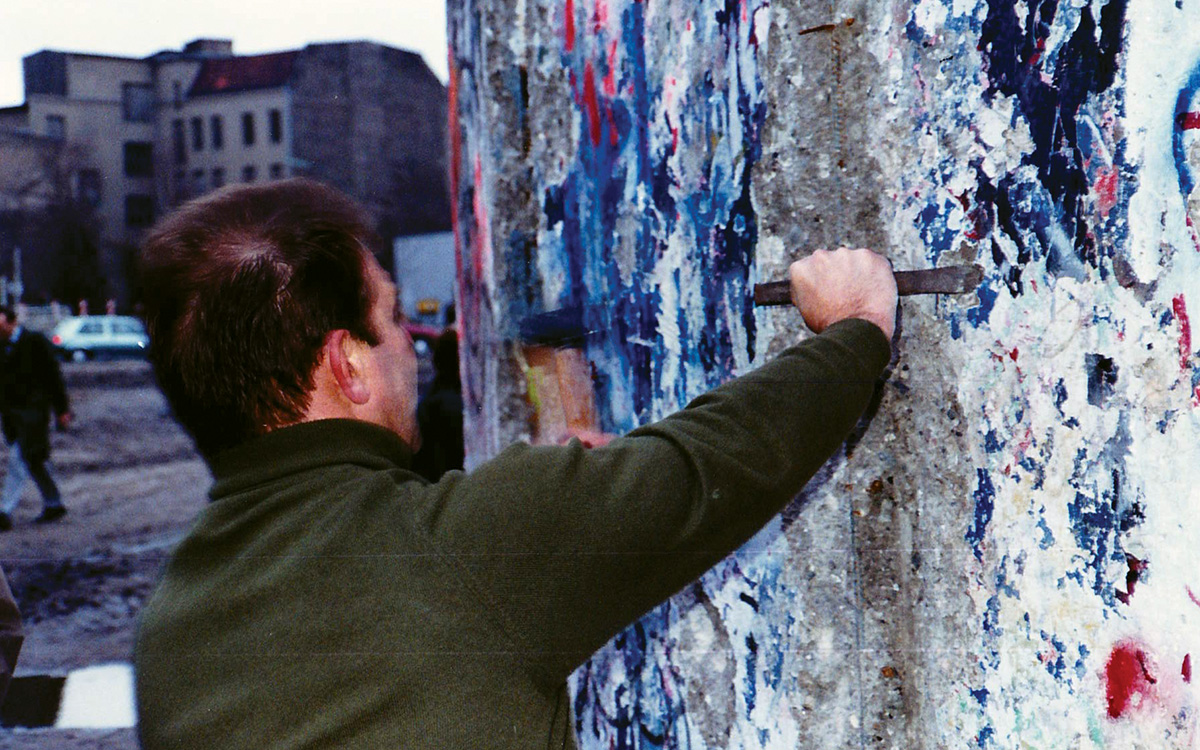
A Berliner attacking the wall with a hammer and chisel.
Courtesy of Greg Suchan
I was in Brussels serving as the labor counselor in what is now the European Union. I covered the International Confederation of Free Trade Unions, which included most of the major unions in the non-communist world. Polish Solidarnosc also had its overseas office in Brussels. And I followed the World Federation of Trade Unions, controlled by the Soviets and headquartered in Prague, which also included communist-controlled unions in the West.
Sitting at home watching the television news Nov. 9, I saw the daughter of a close friend dancing on top of the Berlin Wall as it came tumbling down. My friend had been very active in the fight against communism and had warned his daughter to be very careful in Berlin.
We were all flabbergasted. None of us had anticipated that this would happen so quickly and completely. We had all sensed that the Eastern bloc was in trouble, but we were still surprised when it happened.
The Cold War was a very hot war among the trade unions, with the Soviets pouring money into communist unions while the Social Democratic and Christian Democratic unions, including the AFL-CIO and its affiliates, fought back. This situation—which had existed for 40 years since the communists walked out of a Socialist Congress in Amsterdam, leaving it to the Social Democrats—suddenly collapsed after the fall of the wall.
My job changed radically after that. People who wouldn’t give me the time of day before were now lined up at the mission, wondering if we Americans could help them now that their KGB paychecks were in jeopardy. The head of the Solidarnosc office, who was belittled because he was not one of the well-known principal leaders of Solidarnosc in Poland and whose offices were regularly ransacked by the KGB and Polish intelligence, suddenly became the head of Poland’s National Security Council. The world was being reordered.
With the subsequent collapse of the Soviet Union, we had to help Eastern Europe and the Newly Independent States set up employment offices, unemployment insurance systems and all the other trappings of capitalist, market economies. We had a whole series of meetings in Brussels as the Western countries tried to determine how to proceed in a coordinated fashion to cope with this new world.
Playing a role in all of this was the most interesting and meaningful assignment in my 35 years in the U.S. Foreign Service. I worked long hours but had the satisfaction of knowing I was involved in earthshaking events.
Dan E. Turnquist served in the Foreign Service from 1966 to 2001. He retired as a Minister Counselor and currently splits the year between Centennial, Wyoming, and Guadalajara, Mexico.
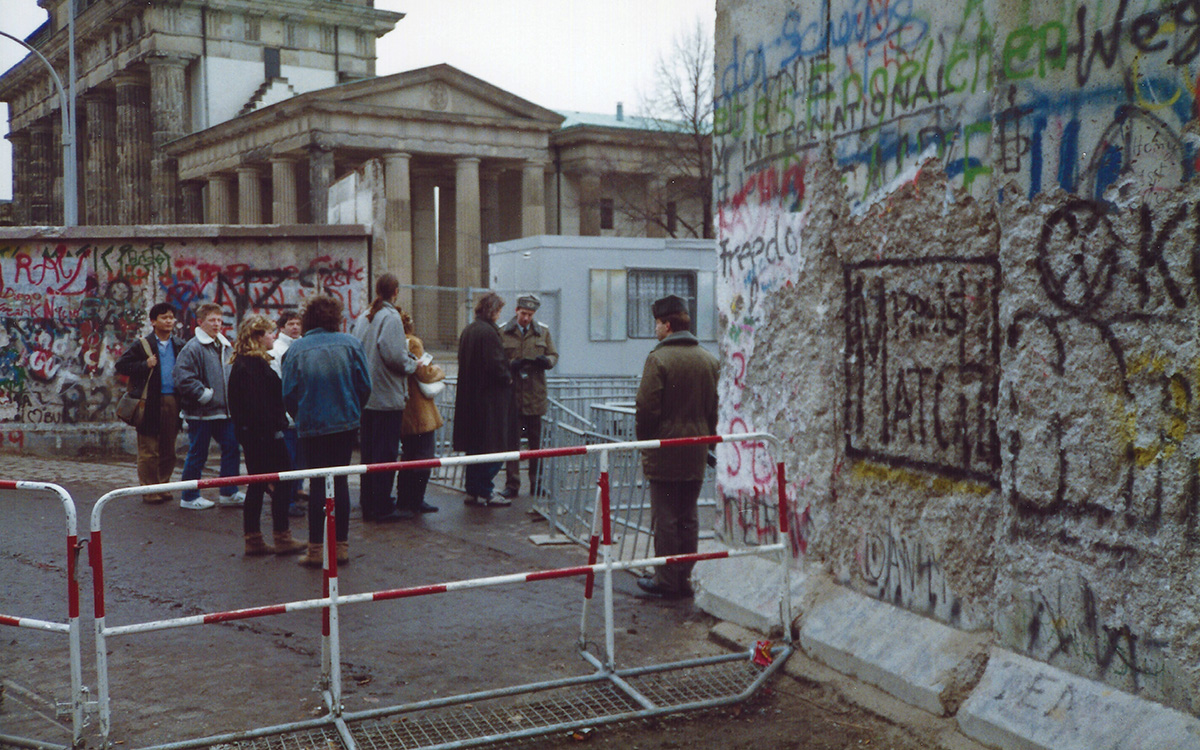
The view into East Berlin from Checkpoint Charlie in January 1990.
Courtesy of Susan Stevenson
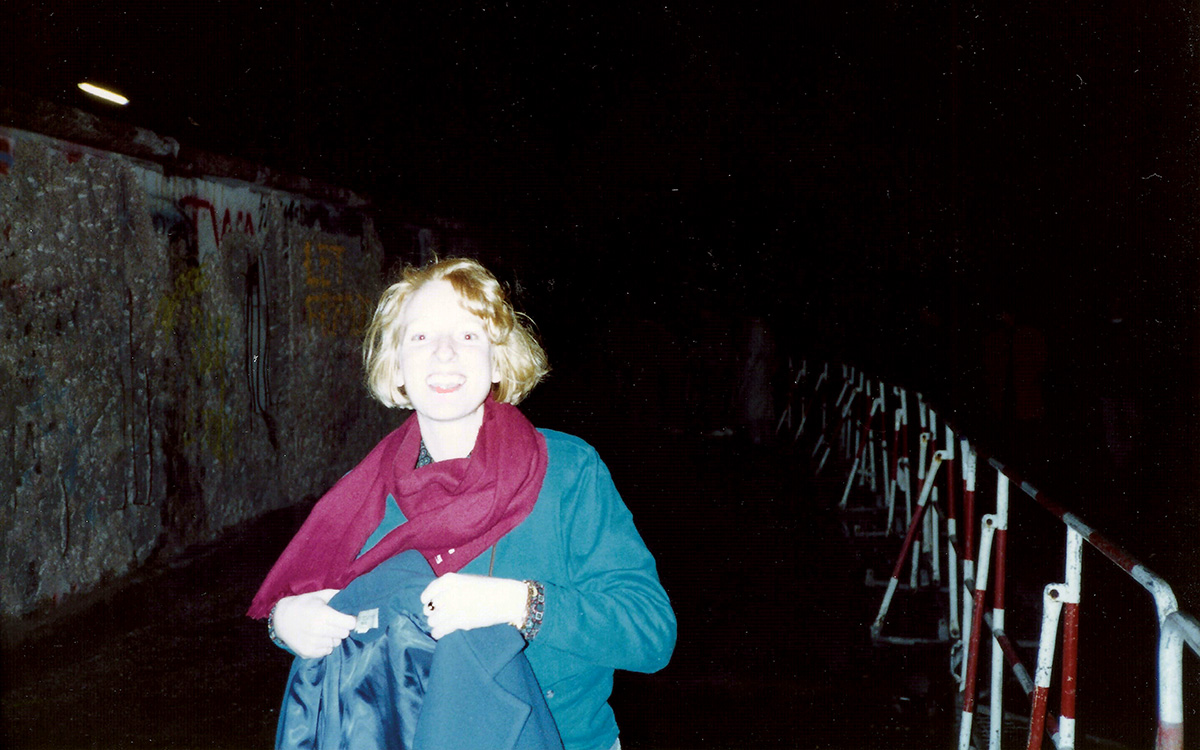
Susan Stevenson near a section of the Berlin Wall in January 1990.
Courtesy of Susan Stevenson
A Good Time for a Visit
Susan N. Stevenson
East Berlin, German Democratic Republic
In November 1989, I was in my second year of work in the private sector and busy planning an international trip. American, French and Scottish friends would join my sister and me on a road trip through what was then Czechoslovakia and East Germany in January 1990.
I remember quite well when the Berlin Wall fell on Nov. 9. We saw the images of hundreds of people crossing from the East into West Berlin, as well as the crowds along the wall. We also heard reports of the Velvet Revolution in Prague and the toppling of leaders there and in Romania. For a few days, we wondered about the wisdom of making our trip.
Luckily, we realized the timing was actually fortuitous, as it would give us firsthand experience of a historic moment. We proceeded as planned, driving from Frankfurt to Prague and then to East Berlin. When we arrived at the Brandenburg Gate in January 1990, we were amazed to find young people sitting on top of the wall, busily hammering away at it. The soundtrack of that trip was the metallic “tap tap tap” of hammers against the concrete to bring down a hated symbol of division and suppression. What mere months before could have gotten them shot—climbing the wall, crossing into the West—was now a joyous moment of community.
I remember sharing a bottle of Russian champagne with two young East Germans on their first-ever trip to West Berlin. They were delighted to meet our international group. They were particularly happy to meet my sister Barbara, who at the time worked for Disney World in Florida, seemingly embodying the American dream. My Foreign Service career was still a few years away, but my interest in international connections was already strong.
We managed to bring back a souvenir: a piece of the wall, which my sister framed.
Susan N. Stevenson was working in the private sector in 1989. She joined the Foreign Service in 1992, and is now serving as ambassador to the Republic of Equatorial Guinea.
The USA Pavilion Goes Forward
Gert Lindenau
Frankfurt, Federal Republic of Germany
In 1989 I was attached to the American consulate general in Frankfurt as director of the U.S. Travel and Tourism Administration for the U.S. Department of Commerce. I was setting up the USA Pavilion at Berlin’s International Tourism Exposition where more than 280 exhibitors from across the United States were expected in March 1990 to meet tour operators and travel agents from all over the world, expanding tourism to their individual destinations and increasing awareness of their services.
When the wall fell in November 1989, it sent shock waves throughout the tourism industry. My office was inundated with questions from potential exhibitors as to what would happen in March. Will all East Germany come? Will I need 100 times the brochures and information to pass out? Will it be safe from terrorists? Will there be enough hotels in Berlin?
Everyone was pleased to see the communist regime implode, and many rightfully expected an increasing number of visitors to the United States in the coming years. For the last day of the exposition, I planned a tour, with the help of buses provided by the U.S. embassy, so U.S. exhibitors could view the remnants of the wall. Participants met the uniformed GDR police officers, who now were very friendly. We saw Checkpoint Charlie and crossed over to East Germany to buy souvenirs (medals, uniform shirts, hats and pieces of the actual wall).
The USA Pavilion was a success even though not many visitors from East Germany were able to attend—they simply didn’t have the Western currency required to participate.
The following years were different for the ITB Berlin, the world’s largest tourism-related fair, and today the United States remains the number one long-haul destination out of German-speaking markets.
Gert Lindenau retired from the Foreign Service in 1993, having served with the U.S. Commerce Department and the U.S. Travel and Tourism Administration. He worked for the Department of Defense in Europe until 2016 and lives with his wife near Kaiserslautern, Germany.
The Berlin Wall as My “Bookend”
John Nix
Nicosia, Cyprus
When the Berlin Wall fell, my wife and I were in the embassy of the Soviet Union in Nicosia, celebrating the USSR’s National Day. At the time, I was chargé d’affaires, and had been for two of the past three years. The Soviet ambassador, with whom I had established quite a close relationship, delivered the news to me.
In fact, the Berlin Wall defined my career. After I graduated from West Point in 1960, my first assignment had been to Berlin as a lieutenant. Not long after my arrival, the wall went up on Aug. 13, 1961. The continuous alerts, the wall patrols, the October 1961 confrontation at Checkpoint Charlie, the many attempts at border crossings by desperate Germans from East Germany—all became iconic pictures I will never forget. Also in the picture: my then-fiancée, now wife of 57 years, who had been born in East Germany and had many relatives there.
After I graduated from West Point in 1960, my first assignment had been to Berlin as a lieutenant. Not long after my arrival, the wall went up.
–John Nix
I had one further assignment to Berlin as an Army officer, from 1969 to 1971, during a somewhat quieter period, when border crossings were more peaceful. After joining the Foreign Service in 1971, we were posted in Moscow and were able to take the Moscow-Berlin train roundtrip twice, after Washington’s diplomatic recognition of East Germany.
At the time the wall fell, I had just learned that my next assignment would be as political adviser (POLAD) to the U.S. mission in Berlin, effectively the deputy chief of mission. We participated in the Two Plus Four negotiations that ensured the withdrawal of Soviet military forces from Eastern Europe, and then the German unification process, followed by many more events that most of us thought we would never see in our lifetimes.
I traveled and reported extensively on the former East Germany, and our efforts were recognized by the State Department’s 1991 Post Reporting Award. In the East we met with, and boosted, future German leaders such as Angela Merkel and Joachim Gauck. Exciting times, indeed.
John Nix served in the U.S. Foreign Service for 25 years, after a career in the U.S. Army. He retired as a Senior Foreign Service officer and lives in Ashburn, Virginia.
Watching from Behind the Iron Curtain
Timothy C. Lawson
Moscow, USSR
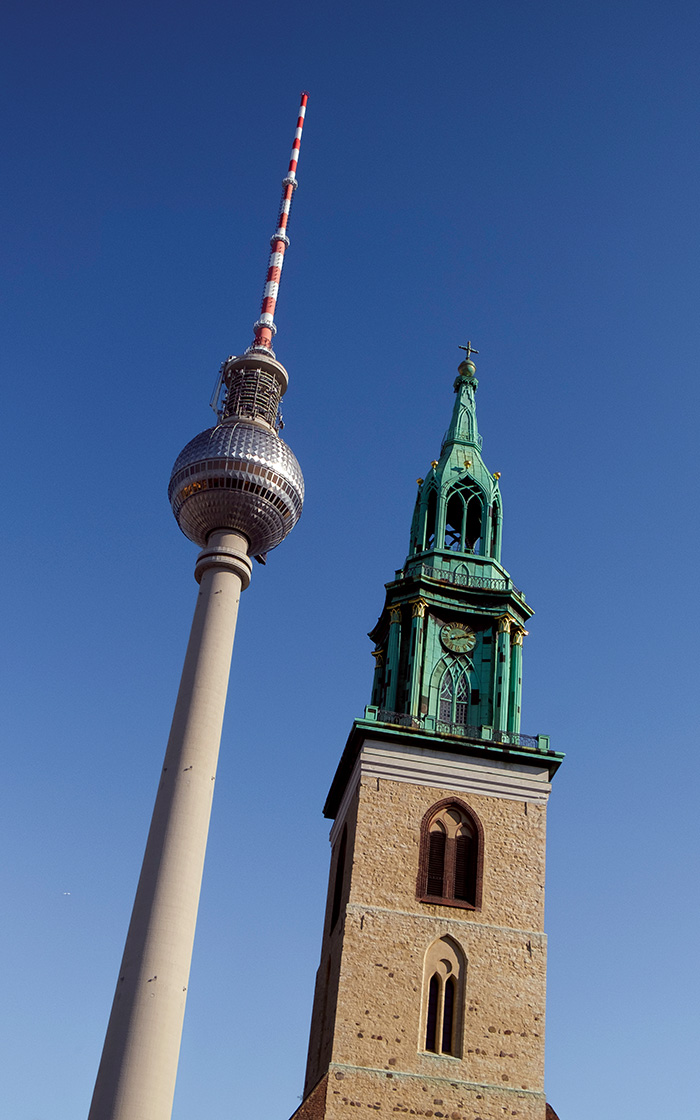
An old Soviet TV tower still stands beside a church in what used to be East Berlin. Berlin, 2015.
James Talalay
Late one afternoon I received a call from Ambassador Jack Matlock, who said he needed to see me urgently. As information resources management chief in Moscow, I was frequently called to the executive office.
The ambassador explained that he had just returned from a lunch with the British ambassador, who had casually asked Amb. Matlock if he was impressed with CNN’s reporting. The query left Matlock fumbling for a response. He never watched CNN reporting since it was not available in our embassy—so what was the Brit’s secret? It was my job to find out.
Our embassy had been asking for almost a decade for cable television access like the “Moscow Channel 1” access we had provided to the Soviet embassy complex in Washington via cable. The answer was always a confused nyet.
There was a good reason for the confusion from the Soviets: as it turned out, the Soviet Union did not have a cable TV system like the U.S. did. CNN was actually freely broadcast through Soviet airwaves across the capital. All you needed was a 10-ruble VHF antenna, readily available at the official GUM department store adjacent to Red Square.
Well, we purchased a bunch of those antennas, and our resident telephone/radio technician installed a broadband UHF antenna on the embassy rooftop.
And just in time! As the first chunks of concrete began to crack and crumble from that all-meaningful Berlin Wall—with Gorbachev’s acquiescence—the CNN signal was distributed via our own cable system, allowing all mission employees to watch it on live television.
Timothy C. Lawson is a retired Senior Foreign Service officer who was serving in Moscow in 1989. He lives in Hua Hin, Thailand.
The Wall, Delivered
Judy Chidester
Kigali, Rwanda
When the Berlin Wall came down, I was working as the information management officer in Kigali. It was a quiet town, and except for the announcement of its fall, little was said of the wall. I did have a wonderful experience related to it, though, that is pure Foreign Service.
When our diplomatic couriers came to town, they normally spent their time at my home. A few months after the fall of the wall, one of the couriers brought me a broken piece of it. It still is one of my most treasured mementos, not only because of what it is but because it reminds me of what wonderful friends the couriers were.
Judy Chidester joined the Foreign Service in 1960 as a cryptographer and retired in 1996 as an information management officer. She lives in Las Cruces, New Mexico.
The View from Rostock
Matt Weiller
Rostock, German Democratic Republic
“Honecker has resigned!” These were the first words I heard on arrival at U.S. Embassy East Berlin in mid- October 1989. East Germany’s longtime leader stepping down was a big deal. But even more momentous events were around the corner.
As a German speaker and a Presidential Management Fellow at the U.S. Information Agency, I was chosen to run “American University Bookstore,” the U.S. government’s first (and last) book exhibit in the German Democratic Republic. The exhibit, consisting of more than 500 textbooks and other materials typical of American university bookstores, was held for two-plus weeks each at Humboldt University in East Berlin, Rostock University in the Baltic Sea port of Rostock, and at the University in Magdeburg in Saxony-Anhalt. The postwar order had been teetering since the summer. But the biggest change was just ahead—and I’d have a front-row seat.
The exhibit kicked off at Humboldt with a mix of cautious optimism and state-sponsored surveillance. Our exhibit was assigned a government minder, a certain Frau Beckmann, a fluent speaker of English, Spanish and Amharic (she learned the latter two languages in Sandinista Nicaragua and Mengistu’s Ethiopia). A steady stream of enthusiastic students visited the exhibit, as did no small number of humorless, bulky gentlemen in bad suits—East German State Security (“Stasi”) agents.
One evening, after the exhibit closed for the day, I accompanied an embassy colleague to a demonstration. Police and security personnel outnumbered the protesters by at least two-to-one. A tentative step toward democracy but not one threatening the regime, I wrongly concluded.
The last weekend in October, I walked to the square in front of the Rotes Rathaus (Red City Hall) to observe another demonstration. This one was attended by well over 20,000 people, venting about issues large and small. Security forces were present but subdued and greatly outnumbered. It reminded me of an oversized school board meeting—fledgling small “d” democracy in action in a peaceful and slightly messy way. Change was definitely afoot, but to what degree?
While I rued having just missed the opportunity to be in Berlin on Nov. 9, I came to realize that very few Americans could attest to having been “in the field” in East Germany on that day.
–Matt Weiller
The following weekend more than a half million people turned out on both sides of the Berlin Wall to protest the regime. The situation had changed exponentially within two weeks. But I still couldn’t imagine what was about to happen.
On Nov. 7, the book exhibit moved on to Rostock. On the evening of Nov. 9, I was strolling through Central Rostock observing what had become regular weekly protests against the regime. I chuckled as I listened to the protesters chanting “Stasi in die Produktion” (very loosely translated as “Stasi get a real job”). As they passed my hotel, I went back to my room. During that time, I received a call from the embassy cultural affairs officer, Peter Clausson, informing me that the Berlin Wall was now open.
Needless to say, the “American University Bookstore” was overshadowed by these events. As the local populace crowded trains and roadways to West Berlin and Hamburg, the dozen or so students assigned to assist (monitor?) me and my staff of two Americans were our primary contacts. Over endless rounds of coffee and cake, the students and other visitors to the exhibit spoke of their initial impressions of West Germany. Despite having spent their lives watching West German TV, they were uniformly struck by West German modernity and effective public services (particularly the street lighting).
While I rued having just missed the opportunity to be in Berlin on Nov. 9, I came to realize that very few Americans could attest to having been “in the field” in East Germany on that day. After Rostock, the exhibit moved on to Magdeburg. Attendance picked up, while surveillance trailed off. Exhibit visitors opened up to us in a way they hadn’t when we started in East Berlin.
We watched similar rapid change unfold in Czechoslovakia, Romania and Bulgaria. While the East German leadership debated how to embrace historic change, there already was a palpable sense that change would overwhelm them in favor of German unification.
Working with the U.S. Information Agency as a Presidential Management Fellow, Matt Weiller was in Rostock, East Germany, when the Berlin Wall fell. He joined the U.S. Foreign Service in 1991 and is now deputy executive director for the Bureaus of Near Eastern and South and Central Asian Affairs.
The View from Shirley Temple Black’s Residence
Michael Hornblow
Prague, Czechoslovakia
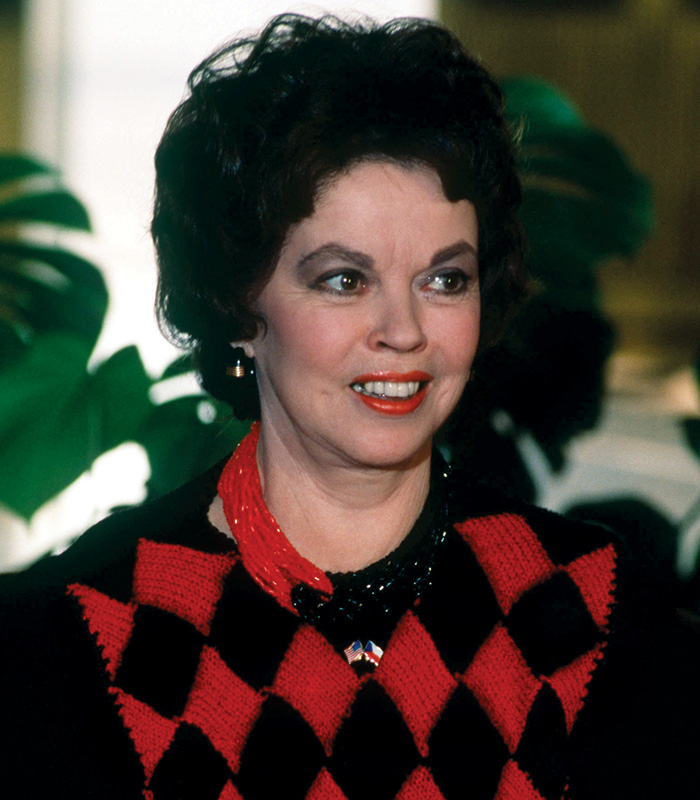
Ambassador Shirley Temple Black in 1990.
Wikimedia Commons
In November 1989 I was deputy director of the Eastern Europe/Yugoslavia office at State, responsible for Poland, Hungary and Czechoslovakia.
My wife, Caroline, and I were visiting the region, which was undergoing rapid change. We had been to Warsaw and Budapest, and it was quiet in the two capitals. Both Poland and Hungary had new democratic governments. The process had been undramatic—nobody had been killed, and there had been no large demonstrations. Czechoslovakia, still under communist control, was a different story. But how long would that continue given developments in neighboring Poland and Hungary? And Prague was filled with thousands of East German refugees seeking a route to West Germany.
Shortly after arriving in Prague either on Nov. 8 or 9, we drove by the West German embassy. That week about 62,000 East German citizens had already left Czechoslovakia for West Germany, and thousands more were coming into Prague every day. When we drove by, the embassy garden was empty and the hundreds of refugees who had slept there in makeshift tents were gone, leaving behind a field of mud.
But everything was peaceful at the extraordinary Petschek Villa, home of the American ambassador, Shirley Temple Black, and her husband, Charlie. Ambassador Black had been in Prague for four months and had become close to Vaclav Havel and his circle. She was constantly urging him to move faster toward freedom and democracy. The license plate on her official car read “STB”—her initials, but also an acronym for the Czech secret police.
On Thursday, Nov. 9, we slept soundly in our room in the residence, the ambassador and Charlie at the other end of a long hallway. As we slept, the events in Berlin were unfolding.
On Friday morning, we turned on BBC radio at our end of the hall. The announcer reported that the Berlin Wall had been breached. We thought nothing of it, believing that yet another truck had barreled through one of the checkpoints. But it soon became clear that it was something quite different. Then our phone rang.
“Michael, this is Shirley. Come quickly. We have the TV on, and the Berlin Wall is falling.”
We walked down that long hallway into the ambassador’s suite. The ambassador was lying on the floor in some sort of a sleeping bag, and Charlie was sitting in a chair, watching CNN. We stayed with them for several hours, eating breakfast in front of the TV while the ambassador shared her memories of the Prague Spring of 1968, when she was stranded in Prague after the Red Army invaded.
We all knew we were witnessing a historic event but did not know what effect it would have on Czechoslovakia. The embassy had arranged for me to have lunch with four or five of Havel’s closest advisers, and we met in a local restaurant, all of us in a celebratory mood. The pilsner was flowing. Of course, the major question was what impact the fall of the wall would have in Prague. Surprisingly, each of the advisers insisted it would not have any impact, saying they were “years away” from anything like that happening. Their views were duly reported back to Washington.
Less than a week later, the Velvet Revolution began. By the end of the year Vaclav Havel was president. The fall of the Berlin Wall did not affect Poland and Hungary directly, but sped up developments in Czechoslovakia, Bulgaria, Romania and Yugoslavia. By the end of the year, all of Eastern Europe was free. The wall’s collapse served as a historic exclamation point: there would be no turning back.
After three years in U.S. Army intelligence, Michael Hornblow joined the U.S. Foreign Service in 1966. He was the deputy director of the Eastern Europe/Yugoslavia office at State in 1989, and now lives in Fearrington Village near Chapel Hill, North Carolina.
Marta at the Book Fair
Don Hausrath
Leipzig, German Democratic Republic
My visits to Leipzig came about before the German Democratic Republic melted away.
I loved visiting the book fair there, for any number of reasons. First, it was fun to visit a country that seemed to have been designed for a noir John le Carré thriller. Buildings still showed scars of World War II street fighting. We would drive through Checkpoint Charlie (“Sie Verlassen den Amerikanischen Sektor”) in our U.S. Information Service station wagon, its diplomatic plates bringing scowls to the faces of the GDR border guards.
East Germany heated their buildings with soft, sulfurous coal; and, thus, even with your eyes closed, you knew you were either in East Berlin or your high school chemistry lab. Dance halls in the GDR appeared to be staged by a 1930s movie director. Men and women sat at small square tables drinking beer. Men wore dark suits and danced with their hats on, a landscape of bouncing fedoras much like a snapshot of the interior of Union Square Station taken in the 1930s. Couples studiously followed Arthur Murray’s Magic Steps as they danced to “Begin the Beguine” and “All of Me.”
Our booth at the Leipzig Fair was always surrounded by fairgoers interested in the new books we displayed, which were of course banned from GDR bookstores. We piled as many titles as possible on a couple of tables and handed out glossy posters of the American Declaration of Independence and U.S. Constitution. These giveaways were prized in a country that did not then have access to such founding documents.
We were forbidden by the authorities to sell or give away our books but turned a blind eye to people who wanted to “steal” a book on display. In any case, security was tight; it was difficult once you had snitched a book to get it out of the building. Besides the casual browsers, there were serious readers sitting about the floor near our display, copying out sections of a book as fast as they could write. So it was that a woman of about 60, whom I will call Marta—I have forgotten her name—sat at our display each year, copying sections of books on American literature. She became a semiofficial fixture, and once I got her to stop long enough to share a coffee.
Marta turned out to be one of those sparkly ESL teachers one finds everywhere around the world. During the conversation, she explained that, like her fellow East Germans, she could not get access to the modern critical works she was salivating over in our display. She wanted her students to update their dated English vocabulary. English versus American literature came up, and she said her dream was to visit London—a common desire of the world’s English teachers. “But I can’t ever get to London,” she said. “My father was allowed out of the country to go to a trade show in Germany, and never returned. I can’t leave because of him. That’s how it works.” And she went back to her copying.
I later received a letter from Marta, thanking me for a book, The Word Finder, that I had mailed to her from my office in Vienna. After that, I never heard from Marta again. My wife and I left Vienna for Virginia three months before the wall came down, and two years later, when we visited Berlin, even the rubble of the wall was gone.
I stood staring at the vacant strip and found myself thinking of Marta. I suppose she went on teaching, but I hope she finally got to London. I think of that gift of The Word Finder, and that sentence about “words that are evocative, that stimulate and unfurl the wings of the imagination,” and pause at “unfurl,” a word that has special meaning for those who have lived in the walled city of East Berlin.
Don Hausrath was a Foreign Service officer with the United States Information Agency from 1971 to 1995. He was posted in Vienna in 1989 and now lives in Tucson, Arizona.
No News, Just Visas
Annie Pforzheimer
Bogotá, Colombia
When the Berlin Wall fell, I was one month into my first tour, as a vice consul in Colombia. There were visas and more visas, using counterfoils and a hand-stamped metal plate, frequent guerrilla-inflicted power outages and phones that didn’t give a dial tone for more than a minute after you picked them up. In Barranquilla in November 1989, the newspapers were full of the drug war and the fact that a girl from a poor part of the city was crowned Miss Colombia. No internet.
I’d like to say I was a witness to this world-shaking event, but it took weeks for it to reach our media and to really sink in. And after it did ... more visas.
Annie Pforzheimer, a recently retired career diplomat with the personal rank of Minister Counselor, was the acting deputy assistant secretary for Afghanistan until March 2019. She lives in Washington, D.C.
Going with the Flow
Robert Hunter
Washington, D.C.
One morning in November 1989, as I recall, there was a major conference of the “great and the good” at one of the Washington think-tanks. Just about every American who was anyone in the field of European security was there, a couple dozen or so. We deliberated all morning about what was happening in what was then called “Eastern” Europe. Discussion was broad and deep, and we even got some things right about the future. But no one among us, no matter how learned and experienced, suggested that the Berlin Wall would open.
And we were right—for about four whole hours! I know of no one in the business—and I knew most of them at the time—who predicted this event, though I later met some people who didn’t know much of anything about Europe who claimed they had predicted it.
The lesson, of course, is that there is a natural inclination—if not compulsion—toward conformity (and attachment to stasis) in foreign policy. The Cold War had generated so much structure—physical (military and economic), political, analytical and psychological—and so many people (on both sides) had become “invested” in the Cold War, that its continuation for the indefinite future was the common assumption. The end of the war was virtually unthinkable, and people who did argue against the broad consensus on the Cold War were mostly marginalized.
Ironically, I had essentially predicted the process whereby the Cold War would eventually end in a book I wrote in 1969, Security in Europe (second edition, 1972). But I fell away from my own insights when I went into government and began to “go with the flow.” Another lesson there!
In November 1989 Robert Hunter was a senior fellow at the Center for Strategic and International Studies in Washington, D.C. He was a National Security Council staffer from 1977 to 1981 and served as U.S. ambassador to NATO from 1993 to 1998. He lives in Washington, D.C.
The Beginning of the End
Pierre Shostal
Checkpoint Charlie, Berlin
In the fall of 1989 I was director of the Office of Central European Affairs (EUR/CE), which covered the German-speaking countries and both West and East Germany, in Washington, D.C. I had planned a visit to several of our posts in November but had not at first intended to visit Berlin. As demonstrations in favor of freedom in East Germany gathered strength, however, I changed my plans.
While visiting U.S. Mission Berlin in West Berlin on Nov. 3, Harry Gilmore, our minister in that city, hosted a dinner attended by the mayor and other city officials. As the evening progressed, the mayor kept receiving reports of a demonstration planned for the next day in East Berlin organized by the union of artists and writers. Crowd size estimates grew with each passing hour until the mayor announced that half a million were expected to attend (as it turned out, perhaps a million came). I decided that I had to be there.
Crossing into East Berlin the next morning through Checkpoint Charlie, I saw large numbers of people streaming toward the site of the rally, the Alexanderplatz. All was quiet and orderly, and many people had brought their children, some even pushing baby carriages with babies inside. Along the streets leading to the Alexanderplatz, young people wearing armbands chanted “Keine Gewalt!” (No Violence!) It was an orderly crowd that stopped in their tracks when a traffic signal turned red. German discipline reigned and people did not seem worried.
Crossing into East Berlin the next morning through Checkpoint Charlie, I saw large numbers of people streaming toward the site of the rally, the Alexanderplatz. All was quiet and orderly.
–Pierre Shostal
At Alexanderplatz, a very large space, there was a huge crowd. There I met up with colleagues from our East Berlin embassy, Jon Greenwald and another officer. Musicians serenaded the gathering, and speaker after speaker proclaimed the people’s desire for more choice, the right to travel abroad and freedom from spying on them. One singer belted out a satirical song with the refrain, “Er ist immer dabei!” (He is always there!)—a reference to the secret police who monitored every aspect of their lives. Despite the seriousness of the issues, the crowd was good-humored and seemed optimistic.
East German police stood well away from the crowd, and no Soviet troops were visible, either. A month earlier, when Mikhail Gorbachev had visited East Berlin to help celebrate the 40th anniversary of the East German regime, he had made it clear that the regime needed to adopt a reform program like his own perestroika in the USSR. The East German leadership had strongly resisted such reform for years, but Gorbachev’s warning was that without reform, East Germany was on its own. The regime remained obdurate, but the public understood Gorbachev’s message and realized that Moscow was not going to crack down on them, as the Soviets had done in 1953 following a workers’ revolt.
That evening Jon Greenwald and I traveled to Dresden, where we attended a performance of Gluck’s opera “Orpheus and Eurydice” at the fabled Semper Opera House. Following the performance, the curtain parted, and all the musical and technical personnel appeared on stage. The lead male singer stepped forward and proclaimed that the country’s artists and musicians were with the entire population in demonstrating for freedom. The house exploded with cheers and applause.
Reflecting on what we had experienced that day, I realized that we had seen the beginning of the end of the East German regime. The people had lost their fear, and the regime had lost its nerve. Five days later the Berlin Wall was opened (it did not fall) by East German border guards, and Europe entered a new chapter of its history. The United States stood by our German friends to help make this happen.
Pierre Shostal served in the Foreign Service from 1959 to 1995. In 1989 he was director of the Office of Central European Affairs in Washington, D.C. Mr. Shostal lives in Alexandria, Virginia.
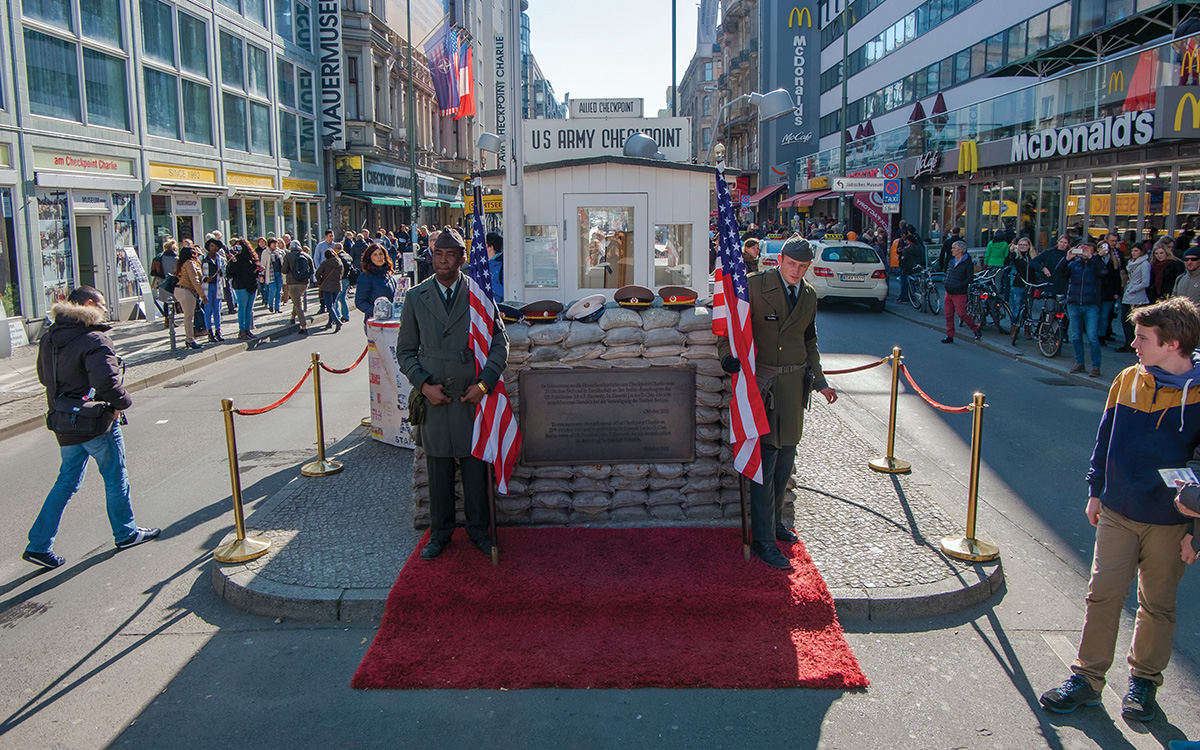
Checkpoint Charlie, one of the best-known border crossings during the Cold War, became a symbol of territorial and political division—between East and West, communism and capitalism, confinement and freedom. Berlin, 2015.
James Talalay
A Family Story
Christiane Armstrong
Budapest, Hungary
On the evening of Nov. 9, 1989, the phone rang in our living room in Budapest. My father was on the line from Germany: “You won’t believe this, the wall just came down.” He was right—I was completely surprised and astounded. In Budapest, our first Foreign Service posting, we didn’t have Western television, and I had not been able to follow the rapidly unfolding events in East Germany over the previous few days.
Of course, we knew what had happened that summer in Hungary. We knew that the West German embassy had been flooded by hundreds of East Germans hoping that if they made it onto embassy grounds, they would somehow be able to get to West Germany. And then on Sept. 11, driving east through Austria on our way back to Budapest from a vacation, we were stunned by the sight of hundreds of Trabis, East Germany’s “people’s car,” going in the opposite direction.
Hungary had, indeed, opened its borders that day. I clearly remember being overjoyed for the East Germans who were suddenly able to leave the Eastern bloc—and envious because we were on our way back to that drab world. As much as I enjoyed our posting in Budapest, with marvelous colleagues and a fantastic ambassador, I could never share our American embassy friends’ enthusiasm for, as they saw it, the “quirkiness” of a communist country.
The things they chuckled about were all too familiar and brought back unpleasant memories from my childhood and teenage years. I was born and raised near Cologne, Germany, the daughter of parents who had fled East Germany when they were in their early 20s, shortly before the wall was built. My father had been an outspoken critic of the East German regime during his high school years. He had been told by the principal of his school one day before his graduation that to prove himself a loyal East German citizen, he would be sent to work in a coal mine for two years before being allowed to study at a university.
East Germany in the late 1960s and 1970s was gray and polluted and stagnant, full of banners with optimistic slogans hanging on decaying buildings.
–Christiane Armstrong
That night my father said goodbye to his mother and father and left for West Berlin; my mother followed him a year later. His parents stayed behind in East Germany, and he was not able to see them for the next seven years. While I was growing up, we were allowed to visit my grandparents, my aunt and my cousin once a year; but those were not happy experiences.
East Germany in the late 1960s and 1970s was gray and polluted and stagnant, full of banners with optimistic slogans hanging on decaying buildings. There was nothing to buy, and my cousin and her friends treated me like a celebrity simply because I was wearing blue jeans, something they could only dream of. Every aspect of the place made me feel uncomfortable. I never knew whether our East German relatives were so welcoming because they genuinely liked us, or whether they were just happy because we showered them with Western goods every time we visited. I was always relieved when we got in the car and started driving back to West Germany.
On the evening of Nov. 9, after hanging up the phone, I remembered those visits. I thought of my cousin, who married an Austrian because that enabled her to leave East Germany; my aunt, who could never bring herself to leave her hometown and found her little niche in the system; and my grandparents, no longer alive, who had lived two-thirds of their lives under dictatorships. But above all, I felt my father’s utter joy about the sudden collapse of the East German regime and the happiness he felt knowing that East Germans would finally be able to live in freedom.
Christiane Armstrong was a Foreign Service spouse for 29 years until her husband’s retirement in 2016. The Armstrongs were in Budapest when the wall came down.
No Inspections, No Guards, Nothing
Kelly Lauritzen
Aschaffenburg, Germany
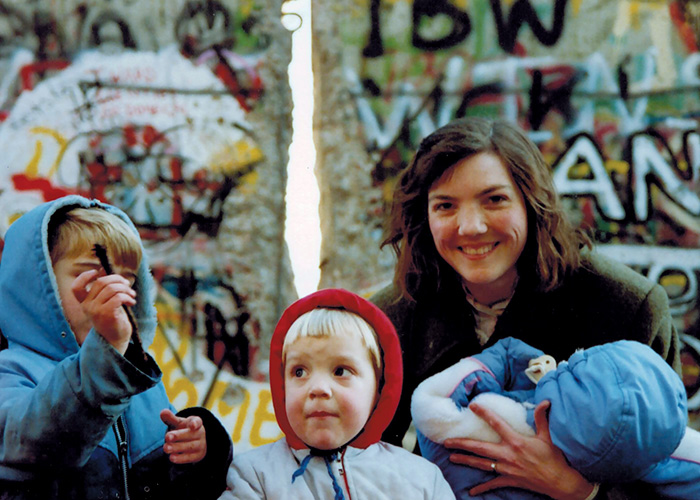
Marion Lauritzen in front of the Berlin Wall with her children in late November 1989.
Courtesy of Kelly Lauritzen
Whack! Off came a chunk from the Berlin Wall. Whack! Another chunk flew. It was two weeks after the Berlin Wall fell, and we were doing our part to reduce it to rubble.
During the Cold War, I was the platoon leader in a nuclear-tipped missile artillery battalion in Aschaffenburg, Germany. The beauty of the countryside belied the tension between East and West that was constantly on our minds. Every day at work, we were literally training for a nuclear holocaust. When cracking the “cookies” with nuclear release codes that came down in the middle of the night, we were never certain until the end that it was a training exercise.
At the time, official military orders authorized military members and their families to travel to the Soviet occupation zone. My wife Marion’s parents had come to visit in October 1989. To give them a taste of communist East Berlin, we decided to travel to Berlin on the military train.
The journey was harrowing. At the border into the Soviet sector, the train was stopped. Soviet guards in fur hats closely examined our papers. The morning after arriving in Berlin, we experienced an even more tense situation at Checkpoint Charlie: concertina wire, machine gun nests, sandbags and inspections.
Strolling through the quiet plazas of East Berlin was quite a contrast to the hustle and bustle of West Berlin. In the shops, you had to ask the clerk to see an item and wait for them to get around to serving you, only to find out that items on the shelf were not actually for sale. Our visit lived up to the billing: it was a fascinating glimpse into the lives of those on the other side.
What we could not have imagined at the time was that two weeks later the whole system would collapse. Watching the TV news, we saw chaotic, joyous scenes with masses of people surging into West Berlin. We immediately knew we had to go back to personally witness this historic change with our three children.
That’s how we found ourselves back at the Berlin Wall just two weeks after it fell. This time, someone had left a series of sledge hammers along a portion of the wall. We each took a few whacks to bring back our own concrete souvenirs. This time, we strolled through Checkpoint Charlie with the curious crowds moving in both directions—no inspections, no guards, nothing.
More than a decade later, I was again stationed in Germany. There were no longer nuclear artillery units; no jets loaded with nuclear weapons sitting on runways ready to take off; and U.S. forces were at a fraction of their former strength.
In the years since, we occasionally feel a pang of nostalgia for the drama of the time. Little did we know that the Berlin Wall would be so completely obliterated that the German government would have to take steps to preserve sections. Now you can buy tiny slivers of concrete attached to postcards—not the fist-sized chunks we smashed out of the Berlin Wall in November 1989.
Kelly Lauritzen is a management-coned Foreign Service officer currently assigned as a consular officer in Guangzhou, China. In 1989 he was serving in the military, based in Aschaffenburg, Germany.
A Gift from a Journalist
James L. Bullock
Moscow, USSR
In November 1989 I was starting my third month as press attaché with U.S. Embassy Moscow’s press and culture section (known as P&C). The Soviets, for some reason I do not recall, did not allow the U.S. Information Service to operate within the USSR under its actual name.
With only Arab-world experience until then, I was not an old Soviet hand. But I had studied Russian in college, so I was asked to break a Bureau of Near Eastern Affairs assignment to fill an unexpected vacancy in Moscow. I was thrilled. It was an exciting time to be heading for the Soviet Union, as Mikhail Gorbachev’s policies of perestroika (restructuring) and glasnost (openness) were upending four decades of Cold War routines.
Embassy Moscow operated primarily out of an antiquated building on the Garden Ring Road, not far from the Kremlin, but without Soviet employees—a lingering consequence of the 1988 Lonetree scandal. By November, we had just driven our personal car down from Helsinki and were beginning to settle in comfortably. Our Moscow apartment came with all of the usual listening devices, a (ridiculously inexpensive) rented upright piano and a TV that could receive CNN in English over the air with just a “rabbit ears” antenna.
The workload in P&C was heavy, in part because of a nonstop VIP visit schedule, but also because I was charged with maintaining the embassy’s administrative relationships with more than 100 resident American journalists. In those days, when properly registered, journalists received special embassy privileges, including medical care, APO mail and—in a city with few restaurants—coveted access to the embassy’s snack bar. I never served at a post, before or after, where they tried so hard to get on my good side.
In any case, on Nov. 9, 1989, and for many evenings thereafter, I was able to follow the earthshaking events in Berlin from the comfort of my living room. CNN’s coverage of the fall of the wall (much better than Soviet coverage) let me watch German civilians hammering away at the wall in real time. My resident American journalist charges, of course, were doing the same thing, and many were soon on their way to cover the Berlin events in person, while I stayed put in Moscow.
Thirty years later, my main memory of that time is of one American journalist, an energetic young woman who had arrived in Moscow not long after me and who had just begun the process of registering for her embassy privileges. I recall her confiding to me that she had a husband back in New York who wanted her to give up the foreign correspondent life and come home to start a family. She wasn’t interested.
Before I got her completely registered with the embassy—it took some time—she, too, was off to cover events in Berlin. When she returned, a few weeks later, she presented me with a small piece of the Berlin Wall. I still have and treasure this personal souvenir, even if she gave it to me just to curry favor. Not long after that she decamped from Moscow for the apparently greater excitement of the fighting in the Balkans where—I later learned from another journalist—she was killed by a piece of shrapnel that had ripped through her. I thought of her husband back in New York.
James L. Bullock, who was serving in Moscow when the wall came down, retired from active duty in 2009 after a 30-year career in the Foreign Service. He and his wife, Carole, live on Capitol Hill in Washington, D.C.
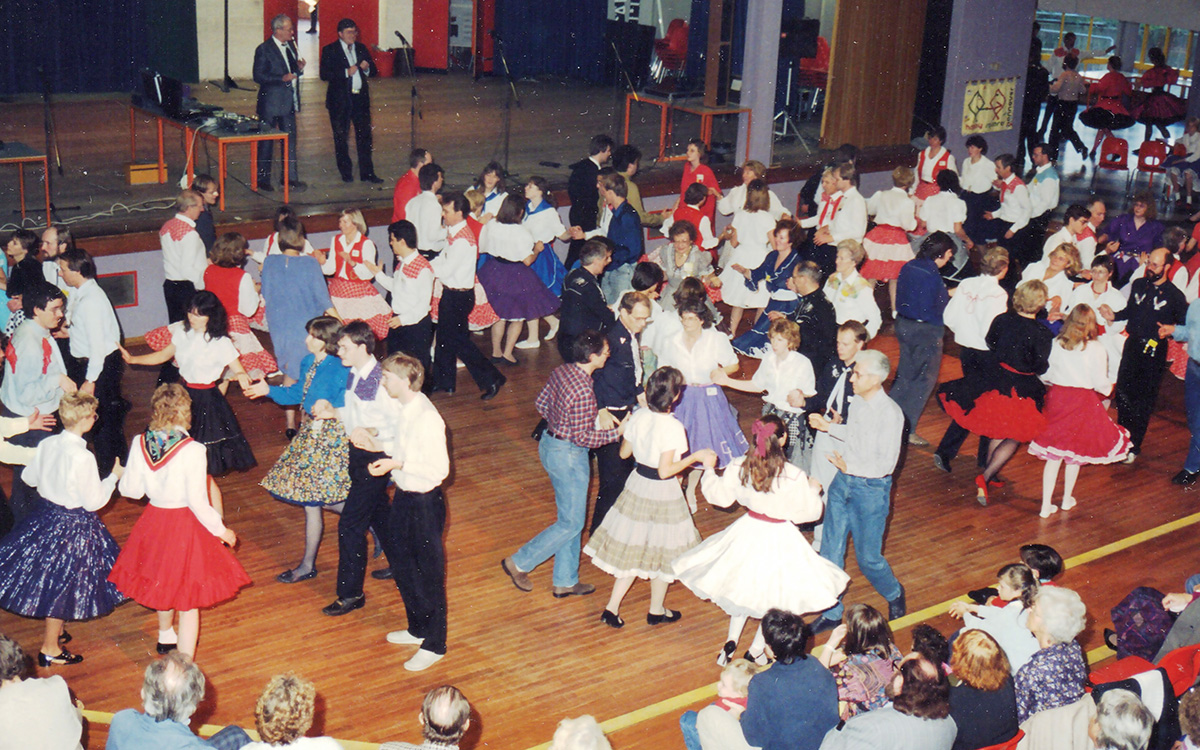
The “Music Days U.S.A.” square dance event in Hanover in late October 1989 drew many enthusiastic dancers.
Courtesy of Ray Orley
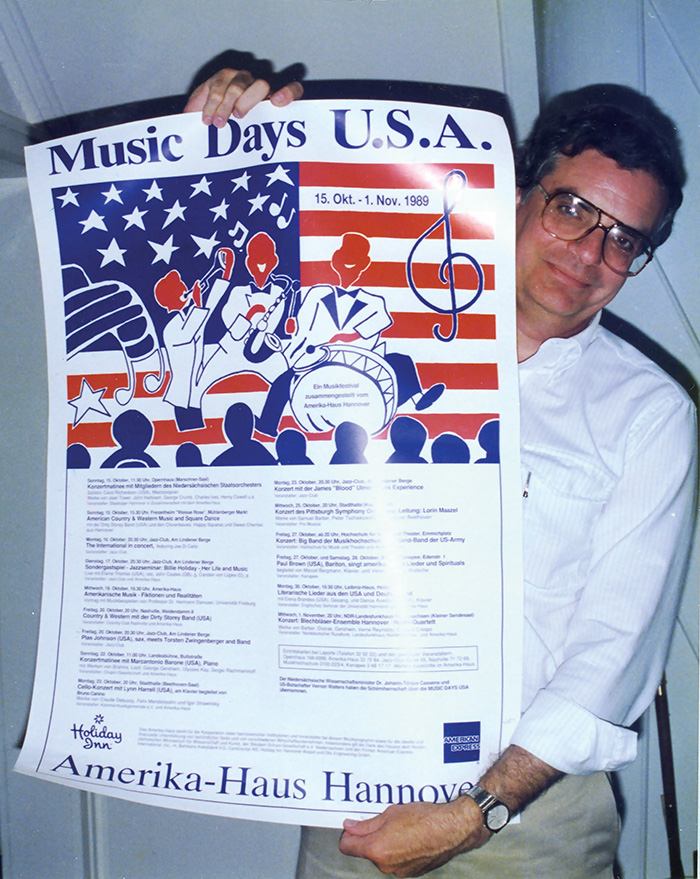
Ray Orley holds the poster for the Amerika-Haus “Music Days U.S.A.” program in Hanover.
Courtesy of Ray Orley
A Vacation from History
Ray Orley
Hanover, Federal Republic of Germany
In early November 1989, I was director of the U.S. Information Agency’s Amerika Haus in Hanover, West Germany. It had been gray, cold and rainy for days, and Music Days U.S.A.—a two-week festival of American music that I dreamed up—had just come to an end.
The festival comprised 15 separate events ranging from Samuel Barber performed by the Pittsburgh Symphony Orchestra under the baton of Lorin Maazel and solo recitals by American singers employed at the Lower Saxony State Opera to performances by rock and country groups (American and German) resident in the area and a real hoedown-style square dance with caller and audience participation. Altogether, some 6,000 Germans attended.
This rather ambitious project could not have been achieved without the valiant efforts of my excellent German staff and the goodwill of many local contacts, as well as more than six months of planning, organizing, phoning, wheedling and begging—all on a close-to-nonexistent budget and in addition to the Haus’ everyday activities. So when it was finally over, I was beyond exhausted—and it was still cold and rainy in Hanover. I headed for a travel agent, looking for a last-minute trip to somewhere, anywhere warm and sunny, and came up with a week for my wife and myself on Tenerife in the Canary Islands. Departure: Saturday, Nov. 11.
But history intervened. For many weeks there had been rumors, rumblings, even demonstrations (in East Berlin!). And then, on Nov. 9, the unimaginable happened. The wall was coming down, dumbfounding all the experts, including of course myself. Amerika Haus Hanover staff and library patrons huddled around the available televisions. Eventually, AH closed for the rest of the day. I rushed home. Wendy and I hugged each other, utterly glued to the TV, watching hundreds of people laughing, singing, dancing, clambering up the wall.
What to do, what to do? We could hop in the Jetta, speed (no German limits) the 180 autobahn miles to Berlin and join the dancing, the beer guzzling, the rejoicing … maybe not the wall-climbing. Previously, because we had diplomatic plates, the advance planning and red tape involved in that drive would have been monstrous. Now, we heard, the border was unmanned, all the way to the Brandenburg Gate and beyond.
But there were those tickets to Tenerife, our flight departing very early Saturday morning. Hanover (and probably Berlin) was still miserably cold and rainy. I really needed to relax after the music festival. I won’t keep you guessing. With some regrets, certainly, we chose the Canaries over history—and, I have to admit, we had a great week there, with only a couple of guilt pangs in the mix.
The following Sunday, Nov. 19, when we made our way from Hanover airport to the central city, we were rewarded with one of the most astonishing, wondrous sights we had ever beheld. Germany had extremely strict Sunday-closing laws; about the only place you could buy anything on Sundays was a very small shop in the central railway station. But on that Sunday, all the downtown department stores and shops were “OFFEN,” welcoming East Germans to load up on the necessities and luxuries that they had so long been denied.
Germans from East and West—you could tell them apart by their clothing—were strolling together, laughing and hugging. Rattletrap East German Trabants, previously a rare sight on West German roads, were everywhere, parked among local Porsches, VWs, Mercedes—or, occasionally, even just left abandoned. The atmosphere was electric, and although the celebratory mood didn’t last terribly long, on that day (cold, but not rainy) the whole thing seemed like some kind of miracle, nearly as good as having been in the Big City on the Big Day itself.
Prior to joining USIA in 1975, Ray Orley was a college drama instructor in the San Francisco Bay Area. He was in Hanover, West Germany, in 1989 and now lives in Albuquerque, New Mexico.
Commuting to East Berlin
Jeff Biron
East Berlin, German Democratic Republic
I was a driver and mail clerk for the U.S. embassy in East Berlin when the Berlin Wall came down. During the late 1980s, the embassy hired both local Americans and third-country national (TCN) employees for administrative positions to both enhance and offset East German staff assigned by the government of the German Democratic Republic. Local U.S. and TCN employees had to be legal residents of West Berlin, speak German and qualify for a security clearance and limited diplomatic status. Every workday we would get up in the morning in lively, colorful West Berlin, go to work through an Allied checkpoint to gray, smoky East Berlin, and then after work, return home to the West.
On Nov. 9, when the announcement was broadcast on German TV that East Germans were being permitted to travel to the West, it didn’t seem like such a big deal. After all, they could always limit the number of permits allowing GDR citizens to leave. East Berliners began lining up by the thousands at border crossings to apply for their travel permits. When my family and I went to bed, they were still obediently standing in line, but as of the next morning, nothing would ever be the same.
We awoke to the sound of cheering and the smell of East German Trabant and Wartburg cars in the street below our apartment in the Kreuzberg district of West Berlin. My family and I joined the celebration that wild weekend. Despite the open gates from East to West Berlin, the East German border guards continued issuing daily visas to visit East Berlin. At least for a while, the roles were reversed, and the Westerners had to stand in line.
Nov. 9 surprised every Berliner, but some signs of change had already been there. In the previous months, when I drove embassy officers to meetings at GDR ministries they commented on the low morale. One economic officer even compared the GDR government to a “house of cards.” East Germans were becoming bolder about listening to AFN (American Forces Network) or RIAS (Radio in the American Sector), or even watching West German TV stations. It was common knowledge among local staff that thousands of East Germans had gone on vacation and weren’t coming back, and that hundreds had sought asylum at West German embassies in Prague, Budapest and Warsaw.
Some 5,000 people were storming the station and trying to board a train carrying hundreds of their countrymen, who were now brand-new citizens of the Federal Republic of Germany.
–Jeff Biron
Because local U.S. and TCN embassy employees were accredited by the GDR Foreign Ministry as technical and administrative staff, we were free to travel through most of East Germany. On Oct. 4, my wife and I were on vacation for a few days in Dresden, staying at a hotel across from the Hauptbahnhof railroad station. On our way back from dinner at the Ratskeller restaurant at City Hall, we started hearing crowd noise and sirens that increased in volume as we got closer to the hotel.
Some 5,000 people were storming the station and trying to board a train carrying hundreds of their countrymen, who were now brand-new citizens of the Federal Republic of Germany. Having sought refuge at the West German embassy in Prague, they had been issued passports and were on their way to the West. The demonstrators dug cobblestones out of the Bahnhofsplatz and were smashing the windows of the station.
The police responded with batons, tear gas and water cannons, but never opened fire. When some noticed that we were from the West, they asked us to please let people back home know what was happening. As soon as we returned to our room, I immediately called Post 1 at the embassy and reported the events in real time to Political Counselor Jonathan Greenwald.
Our embassy, led by Ambassador Richard Barkley and Deputy Chief of Mission J.D. Bindenagel, kept the U.S. government informed right up to the night of Nov. 9. During the weeks that followed, we supported an endless series of congressional delegations and VIP visits, as well as reported and maintained critical contacts during the transition to a reunited Berlin and Germany. Before closing on Oct. 3, 1990, the U.S. embassy to the GDR received an all-hands Superior Honor Award from the Department of State.
Jeff Biron was a local U.S. hire at the embassy in East Berlin when the wall fell. Afterward, he continued to work at Embassy Berlin, and in 2000 he joined the U.S. Foreign Service as a general services officer. He resides in Unity, New Hampshire.
Hungary Played a Role, Too
Donald Kursch
Budapest, Hungary
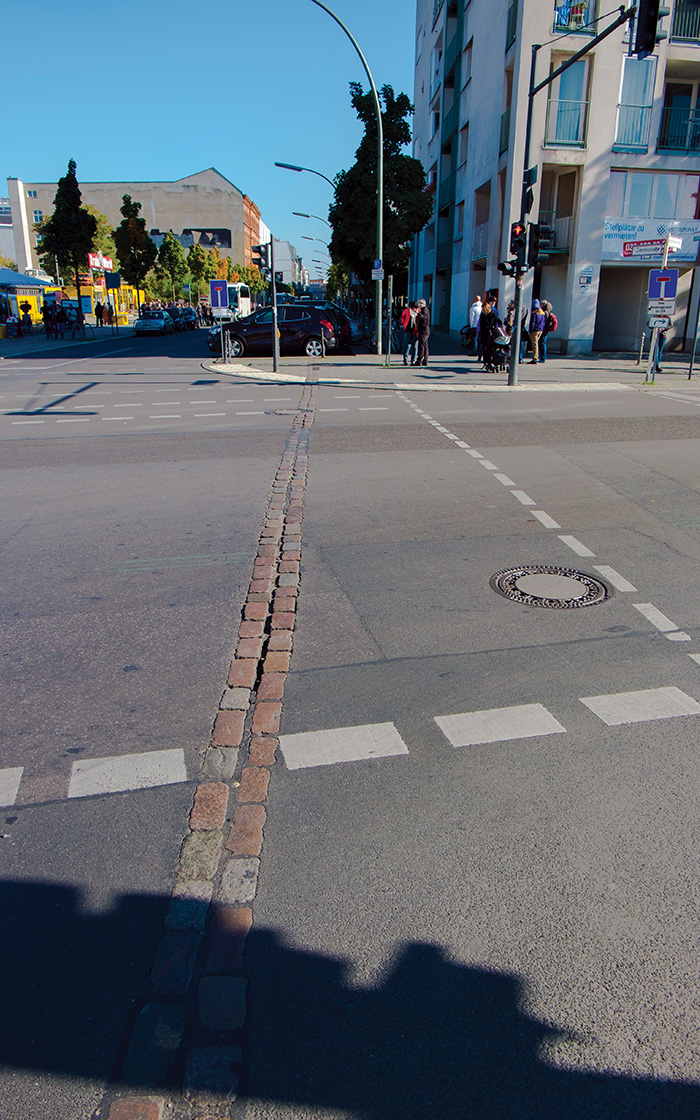
In places where it no longer stands, the path of the Berlin Wall is marked with cobblestones set in the pavement. Berlin, 2015.
James Talalay
I was the deputy chief of mission at U.S. Embassy Budapest when the Berlin Wall was breached in November 1989. Although this historic moment caught us by surprise, as it did almost everyone else, on reflection we saw it as the culmination of a series of events in 1989 that brought the four-decade-long division between Eastern and Western Europe to an end.
The Hungarians were rightfully proud of the forward-leaning role they had played in the process during this momentous year. This included the dismantling of the “Iron Curtain” border impediments with Austria in May; a hero’s reburial in June of former Prime Minister Imre Nagy, who had been executed during the 1956 revolution; the government’s September decision to open its western border for East German vacationers who did not wish to return home; and the proclamation ending the Hungarian People’s Republic and establishing a parliamentary democracy on Oct. 23.
Our ambassador, Mark Palmer, skillfully led our embassy in providing practical and moral support for this process, and President George H.W. Bush’s historic visit in July 1989 made clear that the United States stood behind those who sought to create an open and democratic society in Hungary and elsewhere in Eastern Europe.
In August 1989, while en route to a luncheon at Hungary’s Lake Balaton with visiting Congressman Tom Lantos, I saw a large number of East German–plated cars whose owners appeared to have no intention of returning to the GDR. As these numbers multiplied in the ensuing weeks and these East Germans were directed to temporary facilities in Budapest and elsewhere, it became increasingly evident to me and my embassy colleagues that a weakened Hungarian communist government leadership, struggling to retain some degree of public credibility and under pressure from West Germany’s leaders, would allow these East Germans to leave for the West, which they did on Sept. 10.
In the days prior to this decision it seemed to us as if Erich Honecker and his hard-line compatriots in East Berlin had less appreciation of this reality, clinging instead to the hope that Hungary would somehow force these GDR citizens to return home. Thus, the fall of the Berlin Wall in November may have been a greater surprise to the East German leadership in Berlin than it was for us in Budapest. As we watched the wall collapse, we concluded happily that the process of demolishing the barriers between Eastern and Western Europe had reached the point of no return.
Hungary’s Foreign Minister Gyula Horn, a former hard-line communist who played the key role in the government’s decision to allow the East Germans to leave Hungary, was awarded Europe’s prestigious Charlemagne Prize in 1990 to recognize his outstanding work in the service of European unification. And although Horn’s former communist compatriots, now competing as Democratic Socialists, were soundly defeated in Hungary’s first free elections of the post-communist era in March 1990, Horn survived politically and subsequently led his party back to power, serving as prime minister from 1994 to 1998.
Donald Kursch was deputy chief of mission in Budapest from 1986 to 1990. He was assigned to Bonn in 1990, where he witnessed the formal reunification of Germany in October 1990. Mr. Kursch lives in Washington, D.C.
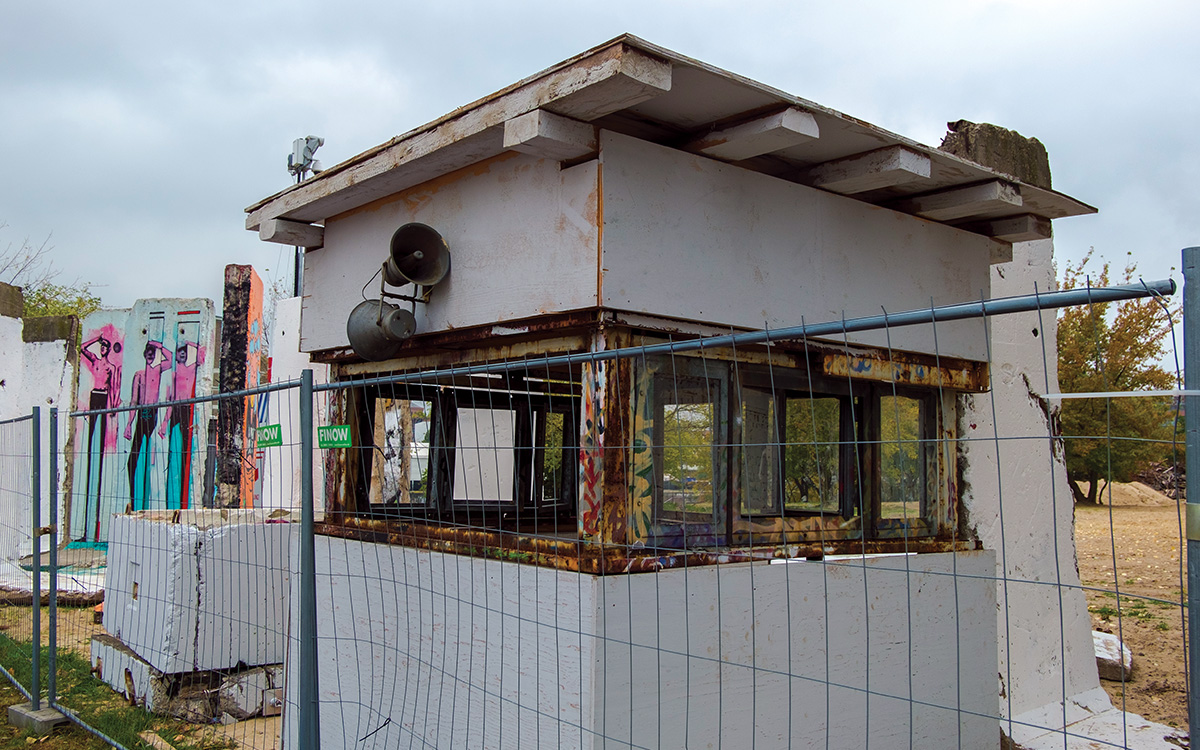
Sections of the wall flank an original guard shack, battered but not removed, on what was the east side of the wall. Berlin, 2015.
James Talalay
A Well-Baby Checkup to Remember
Michael Dodman
West Berlin, Federal Republic of Germany
While I never served or lived in Berlin, the wall is etched on my professional and personal life. Fortuitously assigned to Warsaw for my first tour in 1988, I spent most of the next 25 years working to support Central Europe’s transition to democracy and a market economy. Today, like most everyone, I tend to date the beginning of the end to Nov. 9, 1989, even though I lived through Poland’s first democratic election many months earlier.
But my connection to the wall is more personal than professional. On Nov. 9, 1989, I was in Berlin for the happy occasion of our first-born son’s first well-baby checkup. For more than a year my wife, Joan, and I had been regular visitors to West Berlin. What started as our lifeline for shopping became even more important as the destination for prenatal care, and then the place of our son’s birth in September 1989. What I remember of that fateful day was, first and foremost, that Brian passed that first exam with flying colors (I’d like to think there is a direct line between that exam and his serving with distinction as a U.S. Marine many years later).
Ensconced as always at the temporary duty (TDY) quarters the then-consulate maintained in the far southwest of the city, I do not recall being much affected by the news that the travel restrictions had been lifted. But I remember vividly an early morning visit to downtown Potsdamer Platz, where we had gone regularly over the previous year to see the wall and the disruptions it caused to the once-vibrant center of Berlin.
It was either Nov. 10 or 11. It was incredibly foggy that morning, which made even more surreal the sight of gaps newly created in the wall, through which shabby East German Trabant autos were emerging. Somewhere far away from where I’m writing this, there is a box of old photos with one of an East German guard sticking his head through an opening in the wall—I like to imagine he was debating whether he should make a run for it, in case this magic moment ended, and the wall was resealed.
Over the following year we returned regularly to West Berlin. The hassles remained—renewing short-term East German transit visas, the dance when crossing to East Berlin of not letting the border guards stamp the diplomatic passport—but the changes came ever more rapidly. Now on our visits to Potsdamer Platz we brought a hammer and took home a piece of the wall; there was some sense of urgency about taking pictures of it rapidly disappearing.
In 1999 we returned to Warsaw for a second tour. We loved seeing the changes Poland had experienced in less than a decade; there was no longer the need to travel monthly to Berlin for shopping or medical care. For a vacation in 2001 we piled Brian and his sisters in the car and took the old route to Berlin for the first time. The two-lane road had been nearly destroyed by the freight traffic on the Berlin-Warsaw-Moscow route. Potsdamer Platz was unrecognizable—a sea of construction cranes, with the wall obliterated. City authorities’ wisdom in marking the wall’s path in the pavement helped us get our bearings and provided the spot for Brian to pose for his now-and-then photos behind the Bundestag.
U.S. policy efforts beginning in 1989 stand as the high-water mark of modern American diplomacy, and I will forever be proud of having contributed to these achievements. I am thrilled that Brian’s entry into our life gave me the chance to see the breaching of the Berlin Wall firsthand, and to retain a personal memory of the destruction of the structure that defined the second half of the 20th century.
Michael Dodman was sworn in as U.S. ambassador to the Islamic Republic of Mauritania on December 2017. A career Foreign Service officer, he was assigned to Warsaw as an economic officer on his first tour when the wall fell.
What Followed
Elizabeth Corwin
Warsaw, Poland
In 1989 I was the assistant cultural affairs officer in Warsaw and in a long-distance relationship with a colleague in Bucharest. We got together every six weeks in Warsaw, Bucharest or elsewhere behind the Iron Curtain. Over Veterans Day weekend, we planned to meet in Berlin, but my partner changed his mind and came to Warsaw instead. I’ll never forget waking up on Sunday morning, turning on my shortwave radio and hearing on the BBC that the wall had fallen. I was crestfallen that we hadn’t been there.
On Christmas Day, however, my partner and I spontaneously met in Berlin as the embassy in Bucharest was drawn down the night before. We had a wonderful few days watching “Ossies” streaming over to the West to buy TVs and other goods, and visiting the East ourselves without the Stasi following us.
The last half of 1989 and the first half of 1990 are a blur to me. The Polish Communist Party had lost every open seat in Parliament in June 1989, and all departments of the U.S. government opened up their wallets, offering training programs and sending experts in every field imaginable. The first computer was delivered to the Parliament’s library, courtesy of the Library of Congress. The U.S. Information Service executive officer created special treaty paper for the Ministry of Education so that they could sign an agreement with the Peace Corps.
I found participants for all sorts of new exchange programs in the fields of entrepreneurship, operations management and civic education. The International Visitor Leadership Program went from about 20 participants a year to more than 70 as we sent Solidarity leader after Solidarity leader to the United States. We went from one Eisenhower Fellow to a dozen. Opportunities were limitless.
Mostly, I remember working nonstop, 12 hours a day, six or seven days a week until the spring of 1990, when I was able to add a new cultural specialist to the office. I was overwhelmed by the amount of work; the requests for ideas for new U.S. government programs; the NGOs, American universities and private-sector organizations calling, visiting and writing to inquire about how they could help and what was needed; and, not to mention, official visits by all but one member of the Bush Cabinet and many, many congressional delegations.
There were months when my breakfast was a cafeteria-supplied cheese sandwich at my desk, my lunch was a cafeteria-supplied cheese sandwich at my desk, and my dinner was, well, a cafeteria-supplied cheese sandwich that I’d buy at lunchtime and take home.
Still, I wouldn’t trade those days for anything. It was exhilarating to be in such a dynamic environment and to have such resources. It was fascinating to see a society change so fundamentally, to see economic theory put to work, and to see how creativity and ingenuity can change a culture.
In 2009, I was fortunate to return to that part of the world as the cultural affairs officer in Berlin. I was there for the 20th-anniversary celebrations of the fall of the wall, along with Lech Walesa, Mikhail Gorbachev and Hillary Clinton.
Postscript: Cutting U.S. Information Agency resources in Europe, closing libraries, ending or diminishing exchange programs, shuttering cultural centers—indeed, closing USIA—all because we won the Cold War, has done the United States much harm and may have contributed to the shrinking of individual freedoms and rights currently happening throughout Europe. At the same time, I see values and principles that I fought for and worked on in Poland 30 years ago being stomped on in the United States itself now. Everything seems upside down.
Elizabeth Corwin joined USIA in 1985 and retired from State in 2012. She served in Munich, Warsaw, Athens, New Delhi, Mumbai and Berlin. She lives in Tampa, Florida.
The Voice of America Records History
William H. Hill
Washington, D.C.
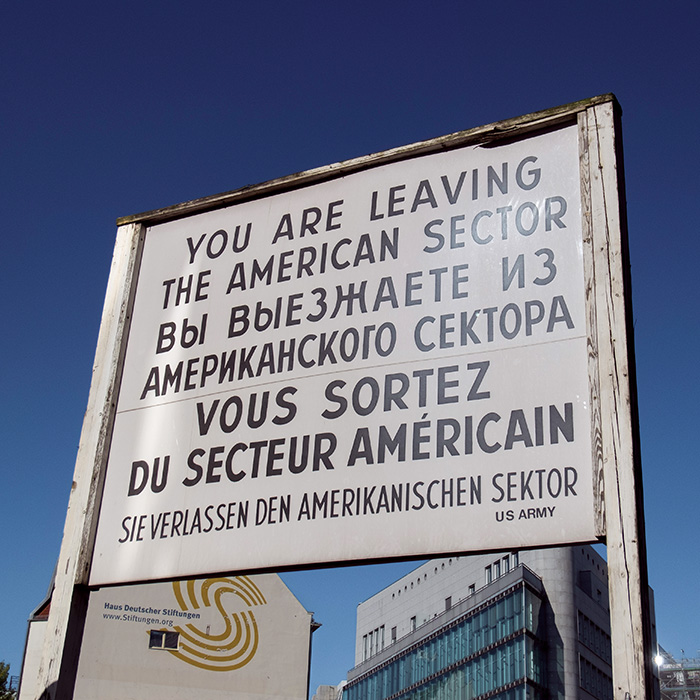
A sign still on display at the site of Checkpoint Charlie, offering a warning from the U.S. Army in four languages. Berlin, 2015.
James Talalay
In late afternoon on Thursday, Nov. 9, 1989, I was at my desk at the Voice of America headquarters on Independence Avenue in Washington, D.C., looking out at the Smithsonian Air and Space Museum just down the street. As chief of VOA’s European division, I supervised broadcasts in 14 languages to countries in Central and Eastern Europe, including a small German-language service. As usual, while I reviewed late-afternoon news and reports from our correspondents and stringers in the field, I had a large television opposite my desk turned on, with the sound off.
My television was most often tuned to CNN, but that day for some reason I had the channel set to NBC News. I glanced at the screen and suddenly turned up the volume, as I saw Tom Brokaw commenting on pictures of German civilians climbing over the Berlin Wall, illuminated in the middle of the night and surrounded by crowds of people. The setting and magnitude of this event was as unmistakable as it was unexpected. Berlin, divided since the airlift of 1948-1949 and construction of the wall in 1961, had come to symbolize the larger division of Europe and the world between the U.S.-led West and the Soviet bloc.
The sudden, unexpected opening of the Berlin Wall was perhaps the most dramatic in a long sequence of events during 1989 that marked the end of the Cold War. As a State Department FSO first detailed in August 1987 to VOA (then a part of the U.S. Information Agency), I had a front-row seat to witness and describe many of the historic events that wound down the decades of conflict between the United States and the USSR. I spent 1987 to 1988 as deputy chief of the USSR division, where I helped organize radio bridges between VOA and USSR state radio, oversaw call-in shows for Russian audiences featuring American rock music and covered the beginnings of the Karabakh movement in Soviet Armenia in February 1988.
In the summer of 1988, I became chief of VOA’s European division, where I had the once-in-a-lifetime opportunity to arrange and supervise coverage of the historic events in Poland, Hungary, East Germany, Czechoslovakia, Bulgaria and Romania that led to the peaceful dissolution of the Warsaw Pact. I was in Poland several times from 1988 to 1989, to negotiate the first permanent VOA news office in a Soviet-bloc country. My Polish service provided live coverage of President George H.W. Bush’s visit to Warsaw in July 1989 and Lech Walesa’s address to a joint session of Congress in November 1989.
The summer and fall of 1989 was a period of growing excitement. Hungarian and Czechoslovak authorities declined to impede a growing flow of East Germans fleeing to West Germany through their countries. The communist government in Hungary was quietly replaced during these events, with the People’s Republic formally replaced by the Republic of Hungary on Oct. 23, 1989.
Gorbachev’s visit to East Germany in early October put the East German government on notice that the Soviet military would not step in to save it from a rising tide of popular opposition. The opening of the Berlin Wall a month later loosed the floodgates of reform in the rest of the Soviets’ European satellites. On Nov. 10, as Veterans Day was being celebrated in Washington, D.C., I returned home after a long bike ride to urgent messages from my Bulgarian service that long-time Bulgarian Communist Party Chief Todor Zhivkov had fallen.
Within a week the ruling Czechoslovak Communist Party also toppled, although it took almost a month for the government to be formally replaced. The hardest nut to crack proved to be Romania, where mass protests led to the arrest and execution of Nicolae Ceausescu and his wife on Christmas Day.
In December I was able to visit Warsaw, where I formally opened the new VOA office; Budapest, where I signed a cooperation agreement with my counterpart from Hungarian State Radio; and Prague, where I witnessed a four-mile-long line of Czechs dancing in the streets to celebrate the fall of the Communist government and had talks with the incoming head of Czechoslovak Radio, so new to his job that he did not know the location of anything in his office.
It is still exhilarating to recall the excitement of that autumn. I believed then, as I do now, that the events of 1989 brought change, hope and opportunity to Europe similar in scope and magnitude to those of 1789. As with the French Revolution, not everything has worked out in the optimistic fashion many of us envisioned three decades ago with the end of the Cold War. There have been clear setbacks and reversals in some of the former Warsaw Pact states. Russia’s relations with the West are not what we had hoped when President George H.W. Bush and Soviet leader Mikhail Gorbachev concluded their groundbreaking Malta summit in December 1989.
Even so, the events of 1989 brought real independence, political pluralism, market economies and elements of the rule of law to most of Central Europe. This, in my view, remains on balance a positive result; it was a privilege to have a front-row seat to witness this process.
William H. Hill is a retired U.S. Foreign Service officer who was chief of VOA’s European Division in 1989. After leaving the State Department, he became a professor of national security strategy at the National War College in Washington, D.C. His most recent book is No Place for Russia: European Security Institutions Since 1989 (Columbia University Press, 2018).
High School in a Divided City
Laura D. Williams
West Berlin, Federal Republic of Germany
On Nov. 9, 1989, I was a 14-year-old student at the John F. Kennedy German-American School in Berlin. My father was the political adviser at U.S. Mission Berlin, located in Clay Compound, the headquarters of the American Sector of the city. That night my parents had gone to see “Dead Poets Society” at the Outpost military theater. I was home alone, ostensibly doing homework but more likely watching MTV—still quite popular in 1989.
Our boxy landline phone had a special red button on it. My parents told me that if I ever took a call on that line, it would be important, so I should use my nicest manners. When the red line rang that evening, I answered. It was the embassy in Bonn asking for my father. The caller told me in a very excited voice that East German travel restrictions had just been lifted, and that I needed to tell my parents as soon as they returned from their outing. I was not sure what this meant, so I called my German boyfriend. He told his parents, who were quite confused. They told us that we must be mistaken. We hung up, and I went back to my math homework and MTV.
An hour later my boyfriend called back to say that we needed to go at once to the Brandenburg Gate, where a large crowd was gathering. It was bitterly cold that night, so I dressed warmly for the trip downtown via U-Bahn and S-Bahn. When we arrived, hundreds of people had gathered. Some with hammers were chipping at the wall, others were singing, still others were drinking and dancing. We walked around for hours, well into the morning. We met Peter Jennings and Tom Brokaw, who were setting up cameras to interview people. They were excited to find English-speaking students, and we had a lively discussion about what this change would mean for East and West Germany.
Getting onto the wall was not easy, as it was some 12 feet tall, but many helping hands boosted us.
–Laura D. Williams
The following days are a blur to me. We kids were excited that school was closed for several days, and everyone was calling family and friends to rejoice. On the second or third day of that delirious, long weekend, I climbed up on the wall in front of the Brandenburg Gate. My mom joined us, but my dad was in his office at Clay Compound, writing cables. Getting onto the wall was not easy, as it was some 12 feet tall, but many helping hands boosted us. Once on our perch, there wasn’t much to do but talk to others and celebrate with champagne toasts. Getting down from the wall in that condition was challenging, to say the least.
Little East German cars—Trabis—filled the streets of West Berlin. Sales of champagne and alcohol exploded. Families separated for decades were able to cross the border and reunite. Rock bands from all over the world flooded into Berlin to play sold-out concerts. Every venue was packed. It was a time of great jubilation.
As a teenager, I had been focused before on things such as trying to emulate the latest Western fashions, like acid-washed jeans and Chuck Taylor shoes. As kids living in West Berlin, 300 miles inside East Germany, my friends and I often felt very disconnected from the outside world. The sudden attention that began on the evening of Nov. 9 blew our minds.
After the Berlin Wall fell and Germany was reunited in October 1990, Berlin acquired big-city problems, immigration issues and crime. My four years there, from 1986 to 1990, were a very lucky time.
Laura D. Williams, a Foreign Service kid, lived in Berlin from 1986 to 1990. She joined the Diplomatic Security Service as a special agent in 2000 and is currently assigned to the Foreign Affairs Security Training Center in Dunn Loring, Virginia.
The Professor Gets It Wrong
Barclay Ward
Sewanee, Tennessee
In November 1989 I was pursuing my second career, teaching at The University of the South (Sewanee), and was asked to speak on the fall of the Berlin Wall to a gathering of students and their parents on family weekend. I think that most of what I had to say about the fall of the wall and its significance for Europe was reasonably accurate, except for my final point: The Soviet Union will never, under any circumstances, accept the reunification of East and West Germany.
Fortunately for me, by January 1990 I was happily working a different temporary job at the U.S. Arms Control and Disarmament Agency, safely removed from my students and their parents—who had been so badly misinformed on family weekend in November.
Barclay Ward was a member of the U.S. Foreign Service from 1961 to 1975. He was a consultant on nuclear nonproliferation at ACDA and the State Department until 2015. Mr. Ward lives in Brookline, Vermont.
From Bulgarian Student to U.S. FSO
Assia Ivantcheva
Sofia, Bulgaria
On Nov. 10, a day after the fall of the Berlin Wall, I was on a bus in my hometown of Sofia. Someone whispered: “Zhivkov is no longer in power.” Another passenger quickly hushed him up. What if it were not true and someone was listening?
Zhivkov had been in power for 35 years, the longest-standing dictator in Eastern Europe. It was difficult to imagine him gone. But it was true. Soon mass protests began; students camped outside the parliament and “occupied” the university, insisting on free elections. I was one of those students, riding the wave of public euphoria. All of a sudden everything seemed possible. While the first election did not bring the swift changes that we hoped for, the course toward a free Europe was set.
1989 was a miraculous year for me. Only four months before the fall of the wall, I was on an exchange-student visit to Moscow State University, where I made friends with some German students from East Berlin. We were all fascinated by perestroika and the freedom the Russians enjoyed back then, the multitude of newspapers and public debates. Ironically, my new German friends and I both thought how lucky the Russians were; none of us thought we would soon see anything like this in our countries. But only months later we were writing letters to each other, describing the miraculous events in Berlin and Sofia, and comparing notes on student movements.
Joining the surge of Eastern Europeans who went to study in the United States, I traveled to New Hampshire, determined to return to the Balkans with a degree. Instead, upon graduating from college I ended up on a fellowship at the Carnegie Endowment for International Peace in Washington, D.C. At that time brutal nationalism and atrocities were spreading across the former Yugoslavia. I advocated passionately for the United States and Europe to intervene as I looked for my “calling” in life.
My calling, as it turned out—once I was a U.S. citizen and earned a Ph.D. in international relations—was to join USAID’s Foreign Service. What better job than providing international assistance to countries experiencing democratic transitions and trying to knock down their own inner “walls”?
I did not quite choose my career; rather, it chose me. My first assignment was to Ukraine, then under President Leonid Kuchma. Few could have predicted the 2004 Orange Revolution—the regime fell without a drop of blood owing to the courage of millions of ordinary Ukrainians who stood in freezing temperatures until the peaceful transfer of power was completed. I recall the tears of joy as I stood at the Maidan in 2005, welcoming the New Year and thinking that, for the second time in my life, I was a part of history. I was proud of my tiny role in the huge collective effort of the international community in support of pro-reform Ukrainian forces. Sadly, governance turned out to be harder than the revolution.
My subsequent assignments were equally amazing; I was thrown into the midst of exciting transitions. I was in Serbia in 2008 when the U.S. embassy was attacked after Kosovo declared independence, and I stayed in Belgrade as “essential personnel,” working with a team literally from my kitchen, until the pre-term election brought to power a new coalition government. Later, I joined the Organization for Security and Cooperation in Europe and was sent to Bishkek in 2010 to facilitate constitutional reforms and election observation after their “revolution.” Sadly, this quickly turned into reporting on the inter-ethnic conflict in the south of the country.
Over the last seven years as a senior adviser for elections and political transitions at USAID, I have been fortunate to be involved in important transitions and elections in Burma, Ukraine, Sri Lanka, Kenya and Zimbabwe. Political transitions have marked my entire life. The fact that I—a former student from Sofia—have represented the U.S. government overseas, was hardly something anyone could have predicted. The fall of the Berlin Wall not only opened up the world for my family and me, it made my professional life more fulfilling than I could ever have imagined.
After the Berlin Wall fell, Assia Ivantcheva left Sofia to study in the United States and later became a U.S. citizen and member of the U.S. Foreign Service. She works in the Elections and Political Transitions Division at USAID’s Center of Excellence on Democracy, Human Rights and Governance.
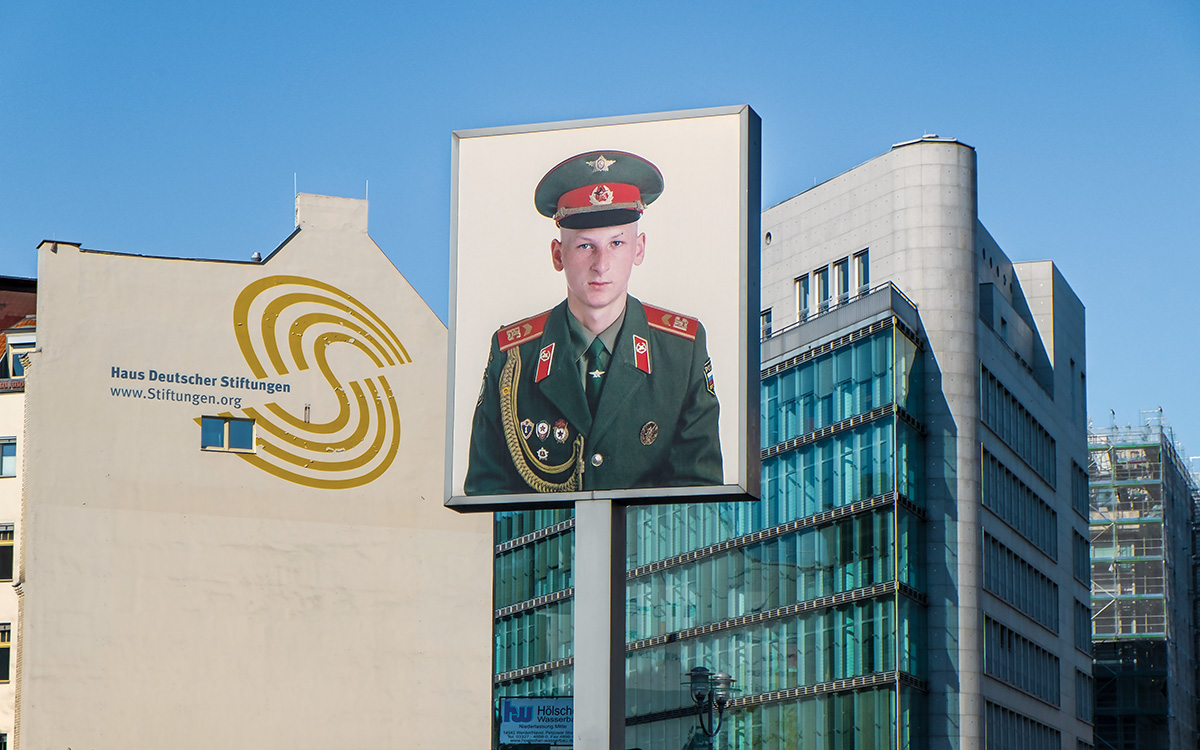
Heading into East Berlin near Checkpoint Charlie is a portrait of an East German soldier; GI Joe is on the other side. Berlin, 2015.
James Talalay
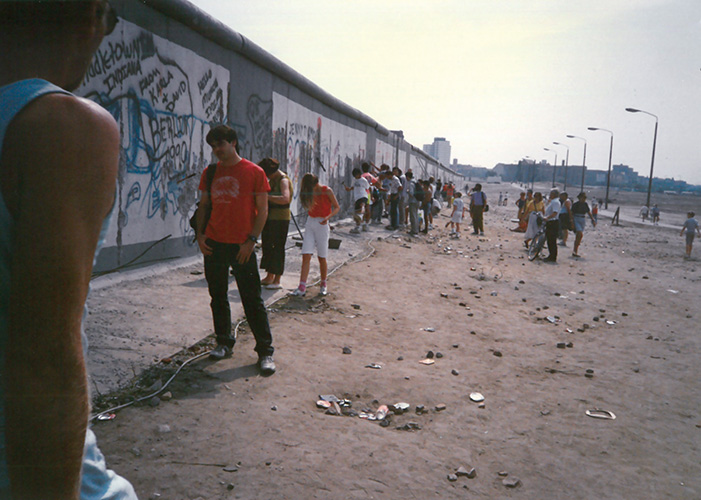
Tourists at the remains of the wall in 1990.
Shawn Dorman
Changes on the Streets
Hank Young
East Berlin, German Democratic Republic
My wife and I were asleep at our home in East Berlin when the wall came down, but we became aware of the change early the next day when we were privileged to watch events unfold on television broadcasts emanating from West Berlin.
As it was a weekend, we needed to shop, and our plan was to cross into West Berlin via Bornholmer Strasse. As we entered this narrow crossing point, we were besieged by gleeful West Berliners essentially stopping our passage with cheers of welcome. They obviously failed to recognize our diplomatic plates and offered us flowers, cans of cold Coca-Cola and bananas. We declined their kind offerings as gracefully as possible, but there were many others crossing at about the same time who gladly accepted the rare gifts.
(By way of background, I recall a previous return from West Berlin, where I had consumed a Coca-Cola. I was carrying the empty can as I left our vehicle, and a young boy of perhaps 12 stopped me to politely ask if he could have the empty can, which I gladly gave him. As I entered our house, I turned to see the Stasi guard assigned to watch our home stop the child to ask what we had talked about. I did my best, struggling in German, to explain that there was nothing sinister transpiring, and the guard let the boy keep the can.)
The Kaufhaus des Westens (KaDeWe) was so congested with East Berliners that they had to queue outside the entrances—the store was packed not so much with shoppers but gawkers, as those from East Berlin didn’t have the proper currency to shop.
The evening after the wall came down, I had a memorable discussion with a neighbor who had an apartment directly across the street, but with whom I’d rarely spoken before. I discovered that he was a history teacher who spoke good English because he had been a prisoner of war in England during World War II.
A few days later, another neighbor welcomed back family members from Ethiopia after the West German government discontinued the aid program for which he had been engaged. All members of his family spoke English, and their daughter eventually was selected to continue her education in the United States.
After the opening of the Berlin Wall and after East Berliners were provided access to German marks, many began renovating their homes. Suddenly an unusual number of old toilets languished on our street for days. As we rode streetcars to and from work, another change we noted was the noise level among the passengers traveling along the route. Previously, the trip was virtually dead silent, with an unwritten code demanding privacy. Now talkative young West Berliners were boarding the streetcars, to the obvious chagrin of the older people, who had ridden street cars in silence for years. Occasionally an older woman would chastise a younger German into silence.
Another notable change was at East German restaurants. Previously, wait staff would be required to wait on one table only, and when the patrons left, that was it for the evening for that waitress or waiter. When West Berliners started dining in East Berlin restaurants, there was seldom enough wait staff to handle walk-in patrons despite there being empty tables. This prompted some lively discussions, with the assertive West Berliners insisting on service.
Hank Young was the management counselor at the U.S. embassy in East Germany in 1989. He served in management positions in 12 overseas posts between 1971 and 2004 and now resides in Asheville, North Carolina.
In the Right Place at the Right Time
Stephen Vogel
Munich, Federal Republic of Germany
I arrived in West Germany in September 1989 as a freelance reporter. I wish I could claim that I had some sense that the Berlin Wall would be coming down soon, but the truth is a friend had suggested I accompany him to Oktoberfest in Munich, and I decided to stick around for a few months to try my hand at stringing for The Washington Post, Army Times and other publications.
On the night of Nov. 9, 1989, I sat in my tiny Munich apartment watching a dubbed version of “Mr. Ed” on television, something I regularly did to improve my high school German. Halfway through the show, as Mr. Ed spoke to Wilbur in German far better than mine, the network scrolled news script below the talking horse: Die Mauer ist gefallen (The wall has fallen).
My German was good enough to know what this meant. I booked the first flight to Berlin the following morning and made my way to Checkpoint Charlie. My focus was on the response of the U.S. military, specifically the U.S. Command Berlin and its 5,500 soldiers.
Jubilant crowds were swarming around the command post, cheering as East Germans in Trabants and Wartburgs puttered their way through the checkpoint and into the West. West Berliners formed lines around the incoming traffic, cheering and thumping on car hoods and handing out flowers, chocolate and champagne to the arriving easterners. Many on both sides were in tears.
It was emotional for me, as well. My father had been stationed in West Berlin as a CIA case officer, and I was born in the U.S. Army Hospital there in 1960. A year later, the wall had been built across the city (not a coincidence, my father told me). I had visited Berlin and gone through Checkpoint Charlie on a high school bicycle trip through Europe with fellow German-language students. Now I was on hand to see the wall breached.
The U.S. soldiers at Checkpoint Charlie were caught up in the joy. “It’s been like a big carnival,” Maj. Bernard Godek, access control officer for the U.S. Command, told me. “It’s difficult not to get wrapped up in the emotion of the moment.”
Revelers spilled over the checkpoint’s traffic island, normally kept free of pedestrians. “We kind of looked at each other and said, ‘Why go out there as Americans and start bossing people around? Why ruin the moment?’” Godek said. “We bent the rules a little bit.”
Celebrants standing on concrete planters in front of the command post knocked over spotlights illuminating the U.S. flag. MPs propped up the lights precariously with crushed beer cans, which were readily available, and pleaded with people to stay off the planters.
East German border guards and American MPs, who normally studiously ignored each other, exchanged friendly greetings.
Despite all the evidence to the contrary, the official U.S. military position was business as usual. On Nov. 12, I found the U.S. commander for Berlin, Maj. Gen. Raymond Haddock, coming through the checkpoint on his way to visit the Soviet sector. “People should not use this to try to change our mission,” General Haddock told me. “Our mission this week is the same as last week, and that is to protect the city, and guard freedom and security for the two million citizens of Berlin.”
That mission did not last long. On Oct. 3, 1990, the day of German unification, I watched the Army’s Berlin Brigade band play “The Stars and Stripes Forever” on a stage in Marx-Engels Square in front of a roaring crowd of Berliners in what until that day had been East Berlin. Four years later, I attended the Berlin Brigade’s deactivation ceremony.
My planned visit of a few months in Germany turned into a five-year stay. In late 1994, I returned to the United States to take a position as a reporter for The Washington Post. I’ve periodically returned to Germany, most recently to research a book about the Berlin espionage tunnel, dug by the CIA and British Secret Intelligence Service before the wall was built. Like many visitors, I found Berlin vibrant, beautiful and, in many ways, unrecognizable from 1989. I took my family to the moving Berlin Wall memorial at Bernauer Strasse. Not for the first time, I felt grateful for the good fortune that allowed me to witness that wall fall.
Stephen Vogel is a journalist and author who covered the fall of the Berlin Wall and reported for The Washington Post for more than two decades. He is the author of Betrayal in Berlin: The True Story of the Cold War’s Most Audacious Espionage Operation, published in September by Custom House, and lives in Barnesville, Maryland.
Movie Night in the American Sector
James A. Williams
West Berlin, Federal Republic of Germany
When the Berlin Wall fell, my wife and I were watching “Dead Poets Society” at an Army theater in the American Sector. At the halfway point the projector stopped, and a voice asked me to come to the office for a phone call. Picking up the receiver, I heard Minister Harry Gilmore say that East Berliners were reportedly swarming into the western sectors of the city. Though that report had not been verified, I went to my office at once. My wife left the theater to link up with our daughter and to get warmer clothes for what was already an incredibly cold November night. They soon joined the growing crowd in front of the Brandenburg Gate.
For four days we saw very little of each other. In Clay Headquarters I led a team that churned out endless sitreps, summaries and analyses for Washington and the world. U.S. Mission Berlin (USBER) and the military commands in Berlin had an extensive network of reporting officers who combined their inputs for joint messages. The system worked well because we had war-gamed similar contingencies earlier that year. We had expected that, as the number of refugees from Eastern Europe continued to rise, the Allied sectors of Berlin would be affected. But we did not expect that the East German regime would open the wall with no planning or notice.
It was fortunate that the United States held the rotating chairmanship of the Allied Kommandatura that November. This meant that we spoke for the three Western sectors, and we coordinated and presented their joint approaches to the Soviet embassy in East Berlin. Those long-established channels worked well. A huge challenge was to make clear to the Soviets that West Berlin authorities had the security situation under control, especially along the wall and near Soviet properties. Working together, the Allies met that challenge.
At the end of that long and joyous weekend, everyone in Berlin was exhausted. Banks had run out of cash because of all the claims for welcome money. Most alcohol in the city had been consumed—incredibly, there was no violence or rowdyism.
–James A. Williams
For four days East Germans swarmed into the Western sectors. They did power shopping with “welcome money” supplied by the government in Bonn. Laden with new purchases, they returned by car, foot and subway to East Berlin. West Berlin was an exotic place to visit, but East Berlin was still home. There were countless tales of West Berliners who had on impulse given goods and groceries to their Eastern brethren. One report claimed that a Mercedes sedan had changed hands that way.
At the end of that long and joyous weekend, everyone in Berlin was exhausted. Banks had run out of cash because of all the claims for welcome money. Most alcohol in the city had been consumed—incredibly, there was no violence or rowdyism. Food stocks were low. Resupply began that Monday, and it never stopped. USBER cut back on flash sitreps, because many readers had acquired Berlin fatigue. I escaped Clay Headquarters for a few hours to walk the city and see what had happened. It was surreal.
The fall of the Berlin Wall was a turning point in history. Those of us who served in Berlin at the time had a privileged seat.
James A. Williams served as political adviser to United States Mission Berlin from 1986 to 1990. Located in Clay Headquarters, for 45 years the hub of the American Sector of Berlin, USBER was part of the Four-Power occupation regime for Germany and Berlin that dated from 1945. Mr. Williams is now retired in Arlington, Virginia.
The View from Suriname
Stanley Myles
Paramaribo, Suriname
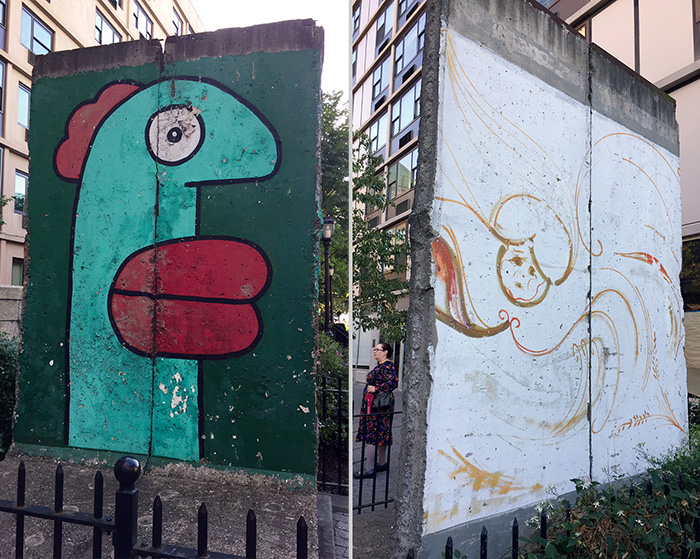
In November 2004, to commemorate the 15th anniversary of the fall of the Berlin Wall, the city of Berlin donated these segments of the inner wall to Battery Park City, NYC. Photos taken Sept. 21, 2019.
Shawn Dorman
In November 1989 I was geographically far removed from the momentous events happening in Berlin and Eastern Europe. Since the summer of 1988 I had been assigned to the American embassy in Paramaribo, Suriname, as the deputy chief of mission. Still, the events in Europe had a powerful impact on the whole world, including among the people of Suriname.
At the time, Suriname had its second democratic government since gaining its independence from the Netherlands in 1975. This government had been elected in 1987 when, under pressure from the Netherlands, the United States and others, the military government that in 1980 overthrew the first democratic government agreed to permit new elections.
However, the new civilian government was weak and unstable, partly because of rivalries among the partners of the ruling coalition, but also because the leader of the 1980 military coup, Dési Bouterse, remained as commander of the Surinamese Army. The United States supported and encouraged the civilian government to resolve its internal divisions and work to decrease the role of the military in national affairs. We at the embassy worked to identify ways that the United States could assist the Surinamese both politically and materially.
The fall of the Berlin Wall gave a powerful boost of hope to all those in Suriname who supported democracy and hoped to develop stronger democratic institutions in the country. I remember a senior Surinamese government official telling me how he hoped that the fall of the wall would lead to “an irresistible tide” of democratic freedom in Suriname and throughout the world.
The dissolution of the Soviet Union further encouraged Surinamers to believe that the forces of authoritarianism were in full retreat, and that the political influence of Bouterse and his supporters would continue to wane. Cooperation between the government and our embassy broadened.
Sadly, these hopes were dashed by a second coup ordered by Bouterse on Christmas Eve 1990. While the military-appointed replacement government was short-lived—forced out in mid-1991 by a second international diplomatic effort led by the United States, the Netherlands and Venezuela—Bouterse, despite being indicted by the Dutch government for involvement in narcotics trafficking, has been democratically elected twice and is currently serving as president of Suriname.
The hope of a civilian government in Suriname free of the influence of its military remains as elusive now as it was 30 years ago when the wall fell.
Stanley Myles joined the U.S. Foreign Service in 1971. In 1989 he was serving as the deputy chief of mission in Paramaribo, Suriname. Mr. Myles resides in Gaithersburg, Maryland.
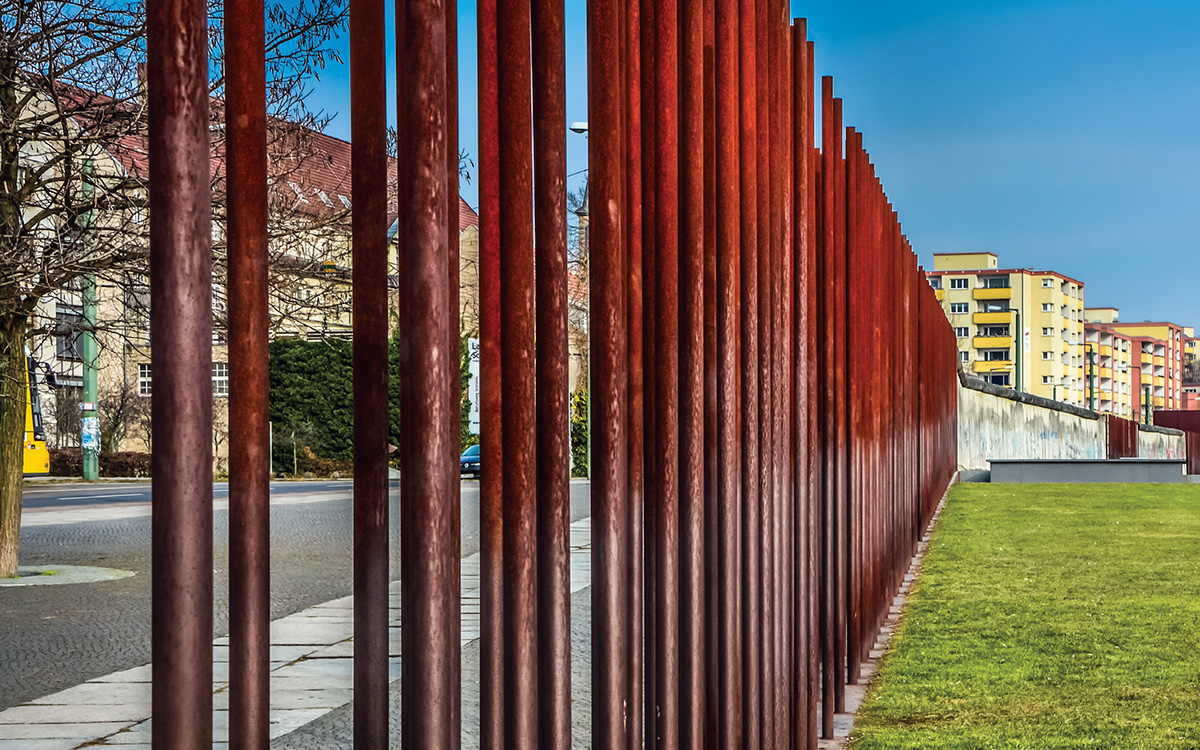
Remains of the Berlin Wall, a historical monument of the Cold War, is today a tourist attraction.
Istockphoto.com / Miodrag Milutinovic
Turn Off the Lights and Lock the Door
Shirley Elizabeth Barnes
West Berlin, Federal Republic of Germany
The Berlin Wall fell in November 1989. German unification occurred on Oct. 3, 1990—two months after my arrival in August as the administrative officer for the U.S. mission in West Berlin. The mission had an overall staff of approximately 500 people, including U.S. Foreign Service officers, German Foreign Service Nationals, locally hired Americans and third country nationals. The administrative section was charged with dismantling and downsizing all things related to general services operations of the mission’s presence in occupied Berlin. The mission’s overall budget totaled approximately $35 million.
What ensued over the next two years was historic and unforgettable, both personally and professionally. From an administrative perspective, it also involved close contact, cooperation and coordination with my counterparts at U.S. Embassy Bonn and with my predecessor, Administrative Officer Don Hayes, as well as Hank Young, an FSO at the U.S. embassy in East Germany. I thank them all.
Dismantling our presence included sale of all kinds of office property and supplies—from copiers to paper clips, to heavy equipment, to housing. It entailed meetings with German officials, occasional meetings with administrative officers representing the French and British occupation missions, American family members, the American School representatives and other American private and nonprofit organizations based in Berlin. And critically, it involved downsizing personnel. It was an era when Europeans in general—and Germans in particular—expected that a job was for a lifetime. This caused enormous stress and anxiety for everyone.
However, nothing was more outstanding and inspiring than my staff, as well as the strong support we had from the embassy in Bonn, including from Ambassador Vernon Walters, Administrative Counselor Harry Geisel (later Ambassador Geisel), U.S. Mission Director Harry Gilmore (later Ambassador Gilmore) and FSO Hank Young. Retired FSOs came in on temporary duty assignments to help us, and we were supported by the U.S. Military Command in Berlin, as well.
Once during our many meetings, Harry Geisel reminded me: “Shirley, as the admin officer, you will have responsibility on the admin side of turning off the lights and locking the door to the U.S. mission’s 45-year presence in Berlin.” I will never forget his words.
Shirley Elizabeth Barnes was an administrative officer at the new U.S. mission in West Berlin beginning in 1990. She served as ambassador to the Republic of Madagascar from 1998 to 2001.





